Green Smoothies Ingredients: Leafy Greens + Fruits

Whether it's leafy greens or fruits, we have a wide range of smoothie ingredients from which we can choose from throughout the year. These can be used to prepare a wide variety of combinations - from sweet to savory green smoothies. If you're a daily green smoothie drinker, we recommend to regularly change your ingredients so that you can take advantage of all the gifts from nature. It's best to get inspired by the seasons, this way you know which leafy greens and fruits are in season. Learn more about what is important when buying leafy greens and fruits, where to shop, how to recognize fresh and ripe ingredients and how to store them.
Table of Contents
- TOP 10 Leafy Greens to use in Green Smoothies
- Ripe Fruits and Vegetables in Green Smoothies
- Water and other Liquids in Green Smoothies
- Warming Spices in Green Smoothies
- Shopping for Green Smoothies Ingredients
- Look for organic quality
- Fresh produce from farmers markets and organic markets
- Post-ripening fruits
- Recognize freshness by cuts, stems and resilience
- Shiny or dull shimmering: both can be an indicator for freshness
- Recognize untreated citrus fruits
- Recognize fresh pineapple
- Recognize fresh melons
- Choosing avocado correctly
- How to properly store Green Smoothie Ingredients in order to keep them fresh
TOP 10 Leafy Greens to use in Green Smoothies
Leafy greens are the most important ingredients in green smoothies. These include: leafy lettuces and cabbage varieties; fresh garden and wild herbs as well as the root greens: beetroot, radishes or kohlrabi. You can even use young leaves from trees and shrubs that bear edible fruits. A simple rule helps to keep track of the large variety of ingredients: Any edible leaves that grow above the ground and can be wrapped around the hand can be used.
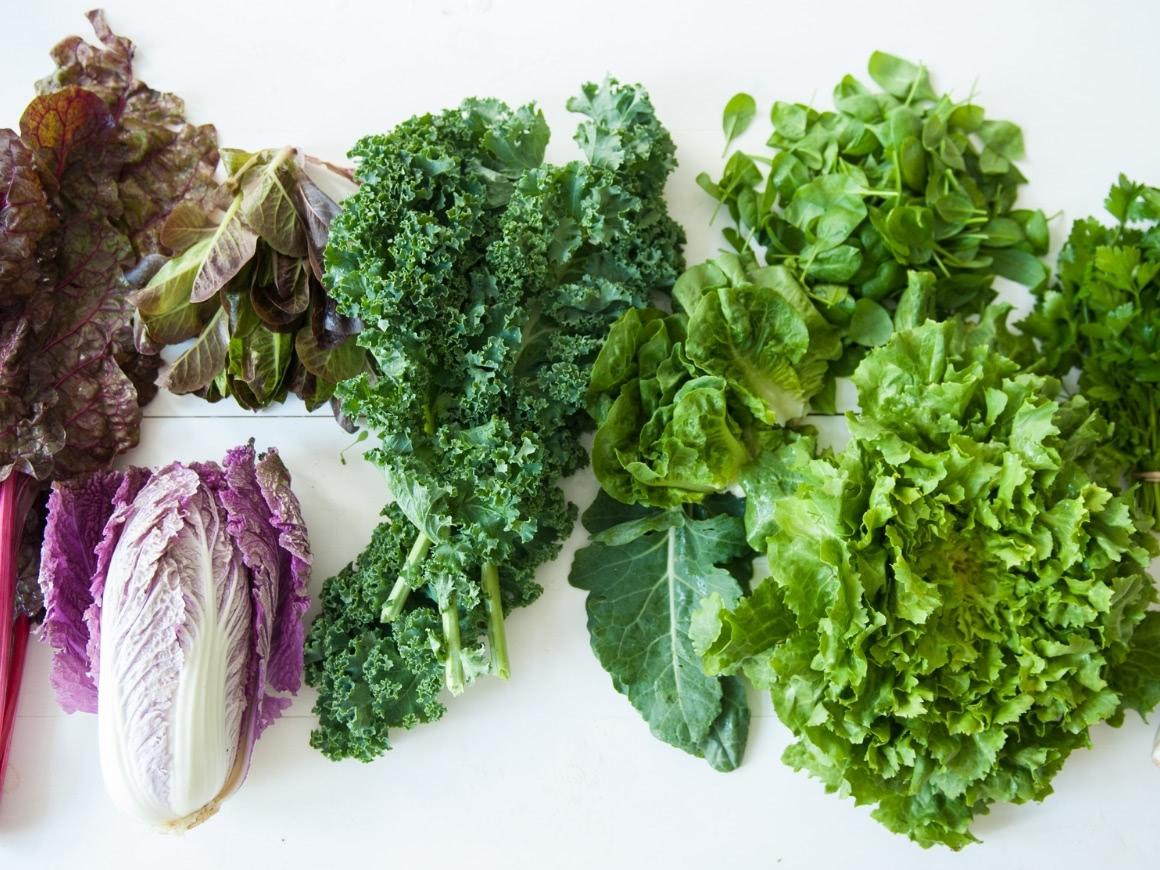
To achieve a creamy-fine green smoothie consstensy, we recommend using a high-speed blender. In the following paragraphs, we will share our personal leafy green favorites, together with our dosage recommendations. The most important selection criteria is: taste in combination with fruits!
Blackberry bush leaves
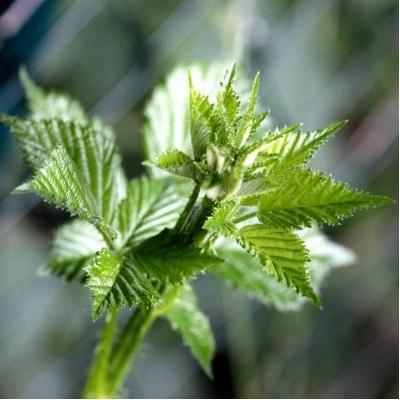 If you have a blackberry bush in your garden, don't just harvest the berries - the leaves deserve a spot in your green smoothie too. They add a pleasant sour note that rounds off the flavor. Our tip: You can also use other berry leaves - for example: try the leaves of strawberries or raspberries.
If you have a blackberry bush in your garden, don't just harvest the berries - the leaves deserve a spot in your green smoothie too. They add a pleasant sour note that rounds off the flavor. Our tip: You can also use other berry leaves - for example: try the leaves of strawberries or raspberries.
Taste: tart, round off smoothie well
Feature: supposed to help against diarrhea
Availability: all year round - if a mild winter conditions allow it
Dosage recommendation: 1 small handful per liter of smoothie alongside a mild leafy green such as spinach or Indian lettuce
Our top 10 Leafy Greens in a PDF file
Yes, I would like to subscribe to the newsletter and receive the TOP 10 Leafy Greens as a printable PDF file for free.
Please send me e-mails, according to the privacy policy, on a regular basis. The Newsletter contains information about kitchen appliances, utensils, recipes and preparation tips, this is revocable at any time.
Endive
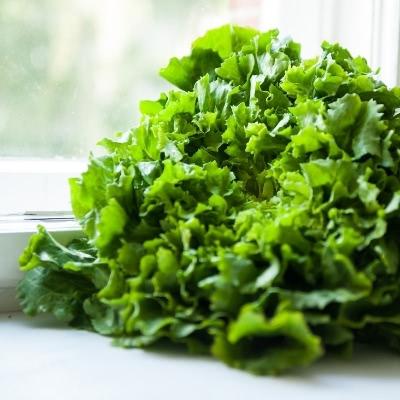 Want an extra dose of detox that turns out fresh and crisp in green smoothies? With its digestive and detoxifying bitter substances, endive is the right choice. Since we discovered this lettuce for the smoothie culture, we often just add a few leaves of endive into the mix. Our tip: The more often you allow bitter flavors, the faster your palate will get used to them.
Want an extra dose of detox that turns out fresh and crisp in green smoothies? With its digestive and detoxifying bitter substances, endive is the right choice. Since we discovered this lettuce for the smoothie culture, we often just add a few leaves of endive into the mix. Our tip: The more often you allow bitter flavors, the faster your palate will get used to them.
Taste: bitter, crisp, fresh
Characteristic: digestive and detoxifying, our favorite lettuce for detoxing
Availability: all year-round; regionally from about May to October
Dosage recommendation: 1 handful per liter of smoothie alongside a mild leafy green like spinach or Indian lettuce
Lamb's lettuce
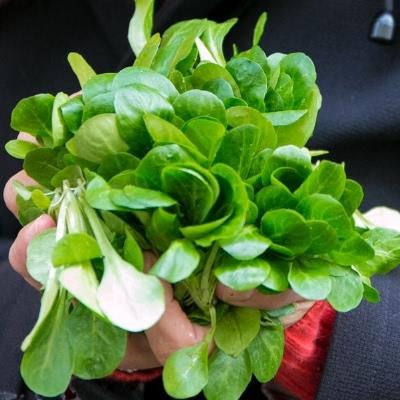 Lamb's lettuce is one of the mildest leafy greens - baby lamb's lettuce in particular is so mild that it is suitable for every smoothie creation you can think of. Because of its low sensitivity to frost, lamb's lettuce can be harvested during the winter months, making it a great fresh leafy green alternative for the cold season. With its high levels of vitamin C, lamb's lettuce can serve well as a cold blocker.
Lamb's lettuce is one of the mildest leafy greens - baby lamb's lettuce in particular is so mild that it is suitable for every smoothie creation you can think of. Because of its low sensitivity to frost, lamb's lettuce can be harvested during the winter months, making it a great fresh leafy green alternative for the cold season. With its high levels of vitamin C, lamb's lettuce can serve well as a cold blocker.
Taste: mild, slightly nutty
Feature: perfect for green smoothies beginners, contains a lot of vitamin C
Availability: all year-round; regionally from about September to March
Dosage recommendation: 1-2 handfuls per liter of smoothie, depending on whether another leafy green is added
Green and black cabbage
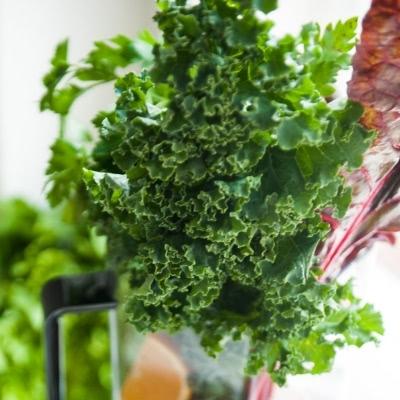 When greens are rare in winter, cabbage is the way to go. We especially appreciate the extremely nutrient-dense kale and black cabbage, with its maximum levels of vitamin C, calcium, iron and vegetable protein. Since kale in particular has a slight spiciness, we advise against combining it with hot spices like ginger or chili. Our tip: To soften the cabbage flavor a bit, simply remove the stalk.
When greens are rare in winter, cabbage is the way to go. We especially appreciate the extremely nutrient-dense kale and black cabbage, with its maximum levels of vitamin C, calcium, iron and vegetable protein. Since kale in particular has a slight spiciness, we advise against combining it with hot spices like ginger or chili. Our tip: To soften the cabbage flavor a bit, simply remove the stalk.
Taste: cabbage-like, green cabbage is slightly spicy, black cabbage is milder
Feature: Superfood with lots of protein, iron, calcium as well as lots of vitamin C
Availability: black cabbage - September to December in organic food stores and farmers markets; kale - from November to March
Dosage recommendation: 4-5 medium leaves (without stalk) per liter of smoothie alongside a mild leafy green like spinach or Indian lettuce
Kohlrabi leaves and radish greens
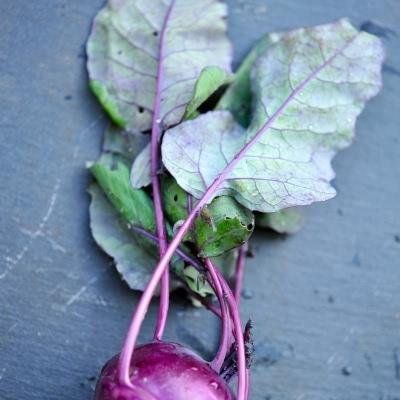 What ends up in other people's organic waste ends up in our blender. And for good reason: In contrast to their tubers, kohlrabi leaves and radish greens taste very mild and can be combined in a variety of ways - whether with sweet or savory fruits. Our tip: Ask for the greens of tubers at farmers markets; sellers will be happy to give them to you for free.
What ends up in other people's organic waste ends up in our blender. And for good reason: In contrast to their tubers, kohlrabi leaves and radish greens taste very mild and can be combined in a variety of ways - whether with sweet or savory fruits. Our tip: Ask for the greens of tubers at farmers markets; sellers will be happy to give them to you for free.
Taste: very mild in taste, Kohlrabi leaves have a slightly kale-like taste
Feature: free of charge, well suited for the start with green smoothies
Availability: both all year-round, regionally from May to October
Dosage recommendation: 4-5 medium kohlrabi leaves per liter of smoothie alongside another leafy green, or the entire leaves from a bunch of radishes per liter of smoothie
Parsley
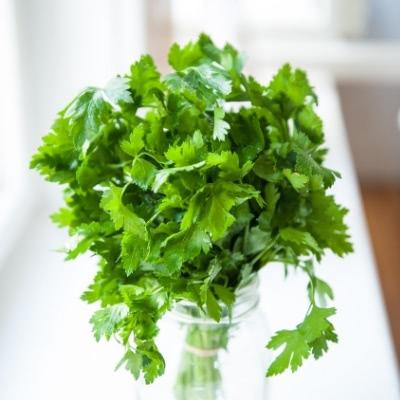 Simply good! Parsley is available all year round, can be combined in many ways with local and exotic fruits and is also rich in vitamins and minerals. Our tip: We recommend flat leaf parsley, it tastes finer than the curly variety. Other, lesser-known garden herbs that can also be used to make excellent green smoothies are: Borage and Burnet - ask for them at farmer's markets.
Simply good! Parsley is available all year round, can be combined in many ways with local and exotic fruits and is also rich in vitamins and minerals. Our tip: We recommend flat leaf parsley, it tastes finer than the curly variety. Other, lesser-known garden herbs that can also be used to make excellent green smoothies are: Borage and Burnet - ask for them at farmer's markets.
Taste: herbaceous, dominant (use flat leaf parsley)
Feature: nutrient-rich, dose carefully during pregnancy
Availability: In flowerpot all year, as a bunch from May to October regionally
Dosage recommendation: ½ bunch per liter of smoothie alongside a mild leafy green such as spinach or Indian lettuce
Indian lettuce
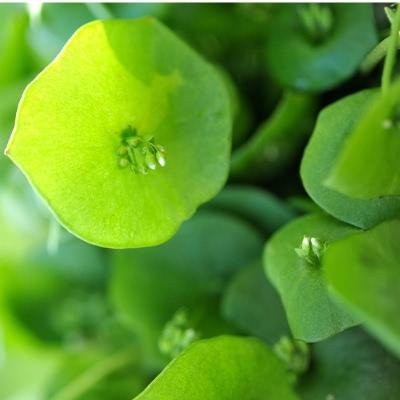 The still quite unknown winter salad Indian lettuce is the reason why we are looking forward to the cold season - from a smoothie point of view. Indian lettuce tastes extremely mild, even milder than spinach or lamb's lettuce and simply makes every smoothie a success. With its extremely high vitamin C content, it offers cold prophylaxis exactly when we need it most. Since Indian lettuce only grows at low temperatures, it is also called winter purslane.
The still quite unknown winter salad Indian lettuce is the reason why we are looking forward to the cold season - from a smoothie point of view. Indian lettuce tastes extremely mild, even milder than spinach or lamb's lettuce and simply makes every smoothie a success. With its extremely high vitamin C content, it offers cold prophylaxis exactly when we need it most. Since Indian lettuce only grows at low temperatures, it is also called winter purslane.
Taste: very mild, fine, juicy
Feature: perfect for green smoothies beginners - can be combined with anything, very high vitamin C content
Availability: regional approximately from November to March (organic stores and farmers' markets)
Dosage recommendation: 2 large handfuls per liter of smoothie
Romaine lettuce
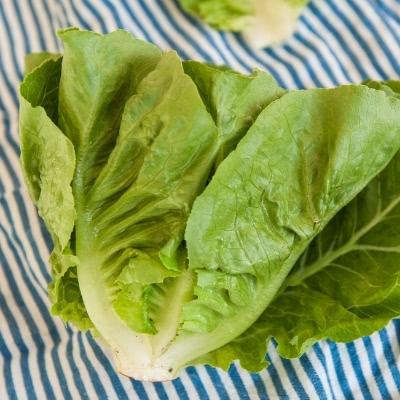 Romaine lettuce is our lettuce of choice. This is because, unlike German lettuce, lollo rosso or even batavia lettuce, it tastes fresh in green smoothies. In summer, it therefore goes well with mild fruit flavors such as melons, apricots, nectarines and peaches. Our tip: add ice cubes to the romaine lettuce mixture - to add that extra bit of freshness.
Romaine lettuce is our lettuce of choice. This is because, unlike German lettuce, lollo rosso or even batavia lettuce, it tastes fresh in green smoothies. In summer, it therefore goes well with mild fruit flavors such as melons, apricots, nectarines and peaches. Our tip: add ice cubes to the romaine lettuce mixture - to add that extra bit of freshness.
Taste: mild
Specials: goes well with mild fruit flavors, our favorite lettuce next to endive
Availability: all year round; regionally approximately from May to October
Dosage recommendation: 1x Romaine lettuce per liter of smoothie
Spinach
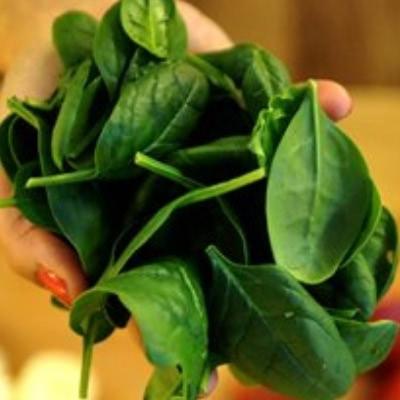 The absolute beginner's favorite. Nice and mild in taste, Spinach can be combined with all fruits and creates a fascinating green. At the same time, spinach scores with lots of iron, potassium, magnesium as well as vitamin C.
The absolute beginner's favorite. Nice and mild in taste, Spinach can be combined with all fruits and creates a fascinating green. At the same time, spinach scores with lots of iron, potassium, magnesium as well as vitamin C.
Our tip: Spinach contains a lot of oxalic acid, you shouldn't use it more than 2-3 times a week .
Taste: very mild
Feature: good for green smoothies beginner's - combinable with anything, lots of vitamin C, iron, potassium and magnesium
Availability: all year round, regionally from April to November
Dosage recommendation: 2 handfuls per liter of smoothie
Wild herbs
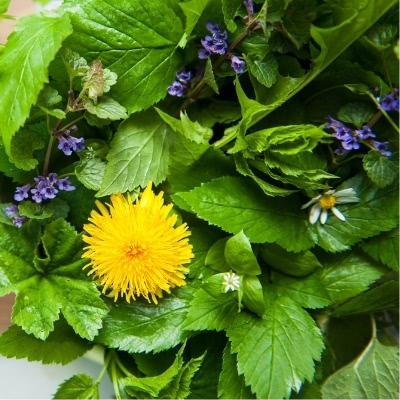 Nettle, dandelion, goutweed - Wild herbs definitely are the Stars in green smoothies. The extreme concentration of nutrients and the fact that they can be found in our backyard for free made us describe them as - real Superfoods. Our tip: Less is more! A small handful in your daily Green Smoothie is completely sufficient. Vary regularly and Only use the herbs that you can identify with certainty!
Nettle, dandelion, goutweed - Wild herbs definitely are the Stars in green smoothies. The extreme concentration of nutrients and the fact that they can be found in our backyard for free made us describe them as - real Superfoods. Our tip: Less is more! A small handful in your daily Green Smoothie is completely sufficient. Vary regularly and Only use the herbs that you can identify with certainty!
Taste: herbaceous, tart, dominant
Characteristics: free superfood with extreme nutrient density, far superior to cultivated plants
Availability: in mild winter weather all year round, best seasonal time - March to October
Dosage recommendation: 1 handful per liter of smoothie alongside a mild leafy green such as spinach or postelet
Our top 10 Leafy Greens in a PDF file
Yes, I would like to subscribe to the newsletter and receive the TOP 10 Leafy Greens as a printable PDF file for free.
Please send me e-mails, according to the privacy policy, on a regular basis. The Newsletter contains information about kitchen appliances, utensils, recipes and preparation tips, this is revocable at any time.
Ripe Fruits and Vegetables in Green Smoothies
Fresh, ripe fruits are the sweet counterpart to leafy greens. They ensure that your green smoothie doesn't taste too bitter or grassy-green. The most important selection criterion for fruits: they must be ripe. If the Green Smoothie is not sweet enough, the fruits used probably weren't ripe. The riper the fruit, the sweeter and more digestible it is. Unripe fruit, on the other hand, can cause digestive problems.
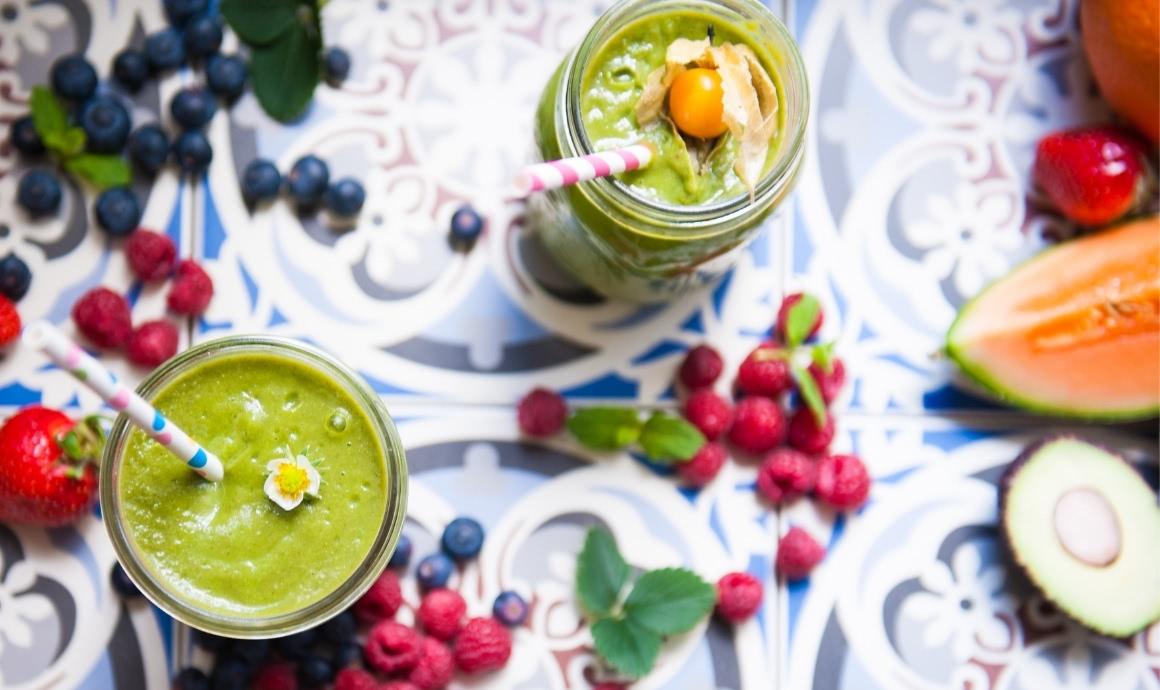
Tip: If possible and in accordance with the taste, use the whole fruit. Seeds and peels often contain important nutrients and, as in the case of citrus fruits, highly aromatic essential oils that don't want to be missed in our green smoothie. Exceptions are stone fruits like peaches, apricots or cherries, whose stones can't even be processed by a high-speed blender.
Local fruits: regional, seasonal and therefore particularly nutritious
It's best to start with fruits that you like and that are currently in season. Local fruits such as apples, pears, in summer berries and stone fruits have the advantage that they can be freshly harvested. They then have the highest possible nutrient content.
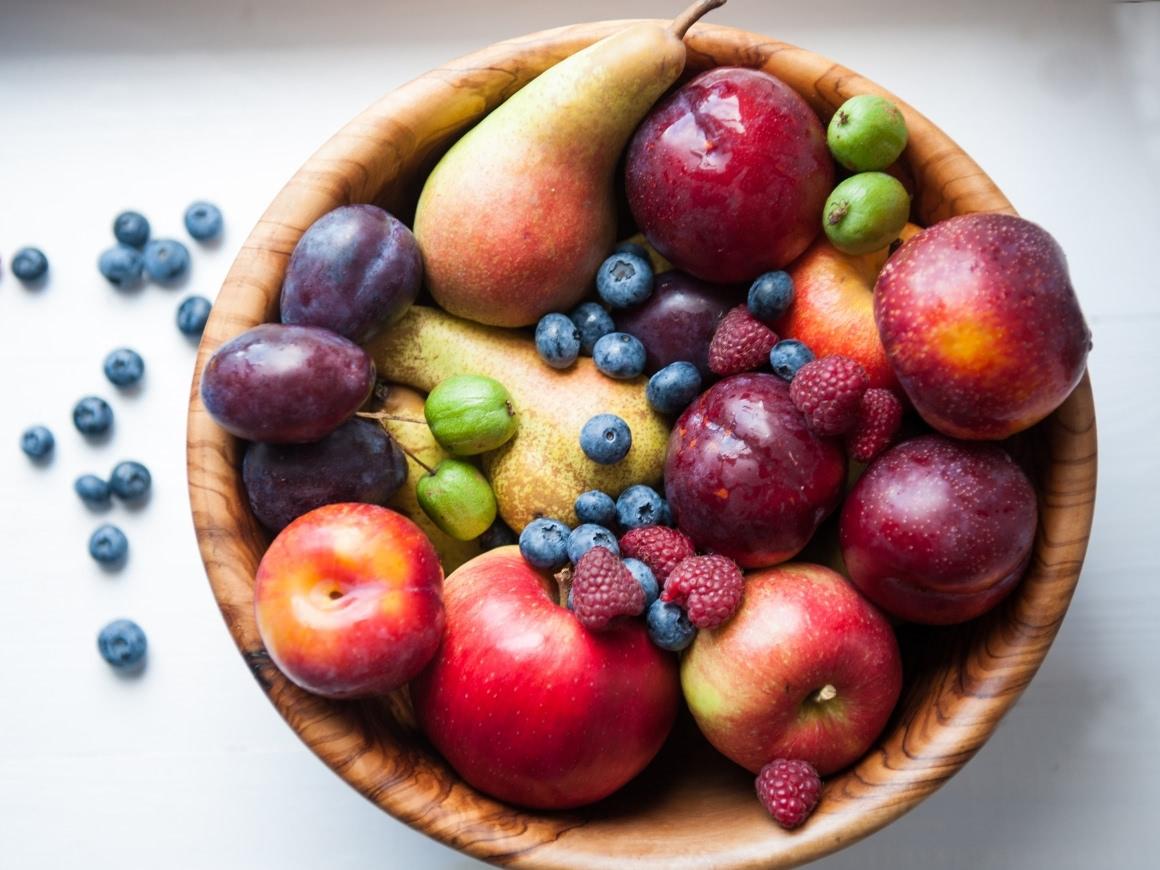
Exotic fruits: provide culinary highlights
At the same time, we have to admit: what would the Green Smoothie be without exotic fruits - especially in winter, when only stored apples and pears are available in this cold country? We love to have pineapple, mango or passion fruit in our smoothie. These exotics can be combined perfectly with other fruits and provide flavorful highlights. Furthermore, a brown spotted banana is perfect for sweetening green smoothies.
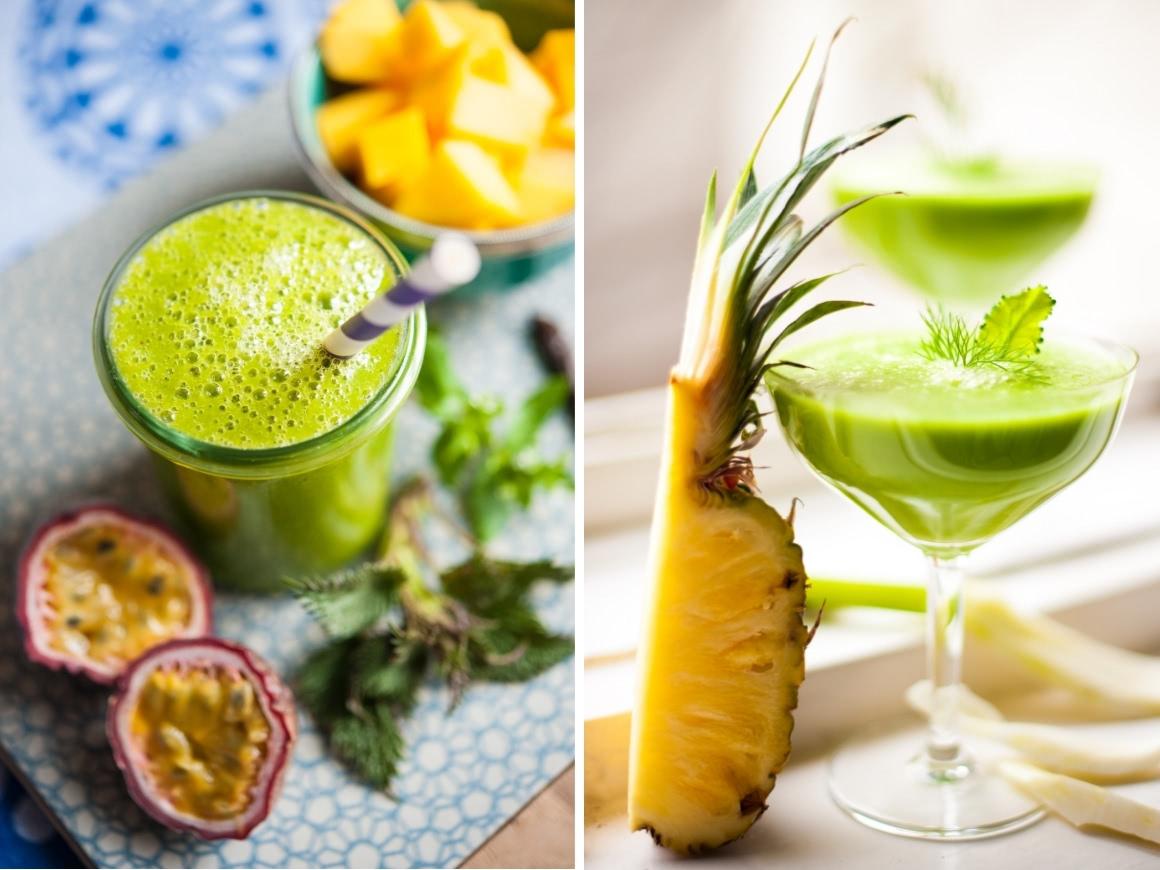
Citrus fruits: wonderfully freshen up green smoothies
Citrus fruits can not be missing in the Green Smoothies. A small piece of lime or lemon with zest can be found in any recipe. They freshen up the Green Smoothie and neutralize the earthy and herbaceous flavors of the leafy greens.
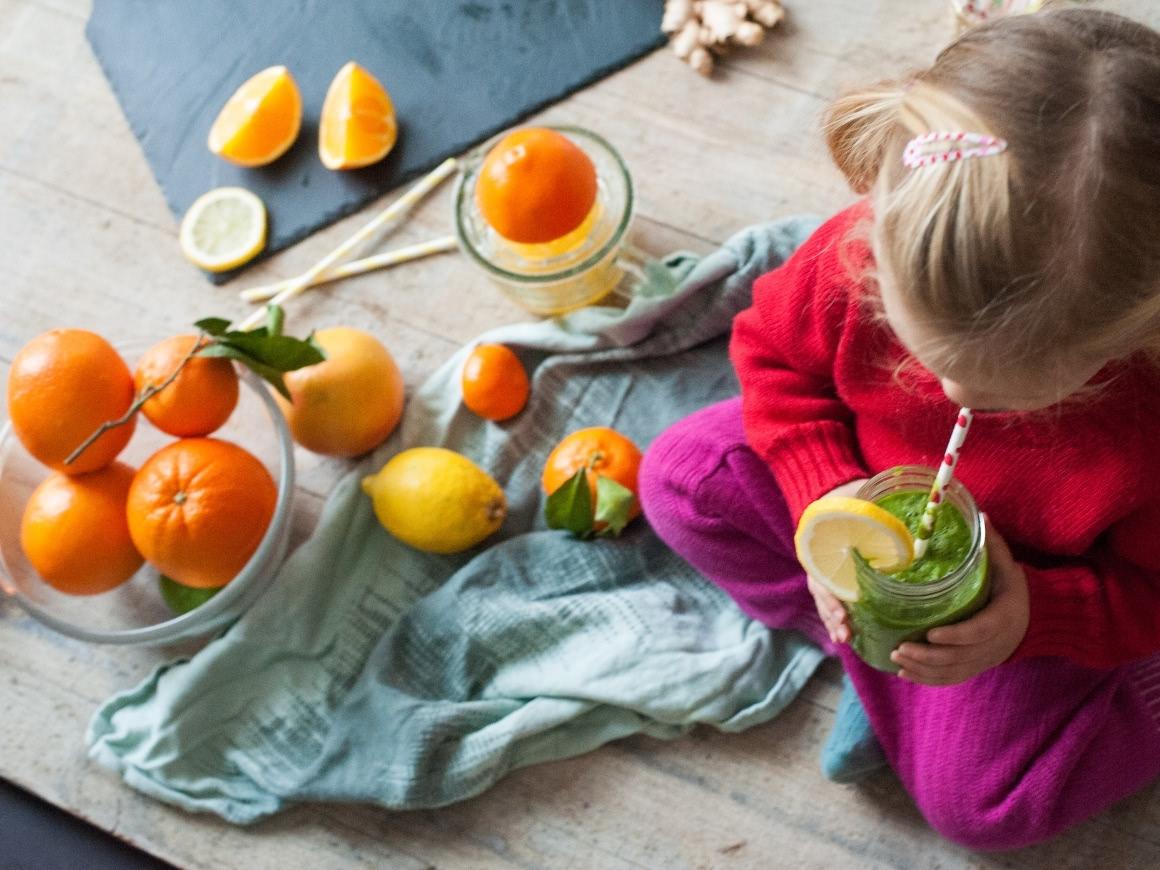
Vegetables: Hearty and low in fructose
Green smoothies don't have to be sweet; they also taste really good in savory variants. Instead of sweet fruits, you can also use so-called vegetable fruits. These include all fruits that grow from a flower. We can recommend tomatoes, cucumbers, avocado, zucchini or muscat squash. To some extent, vegetable fruits also combine well with sweet fruits and reduce the fructose content of a green smoothies. This is especially interesting if you want to lose weight with green smoothies.
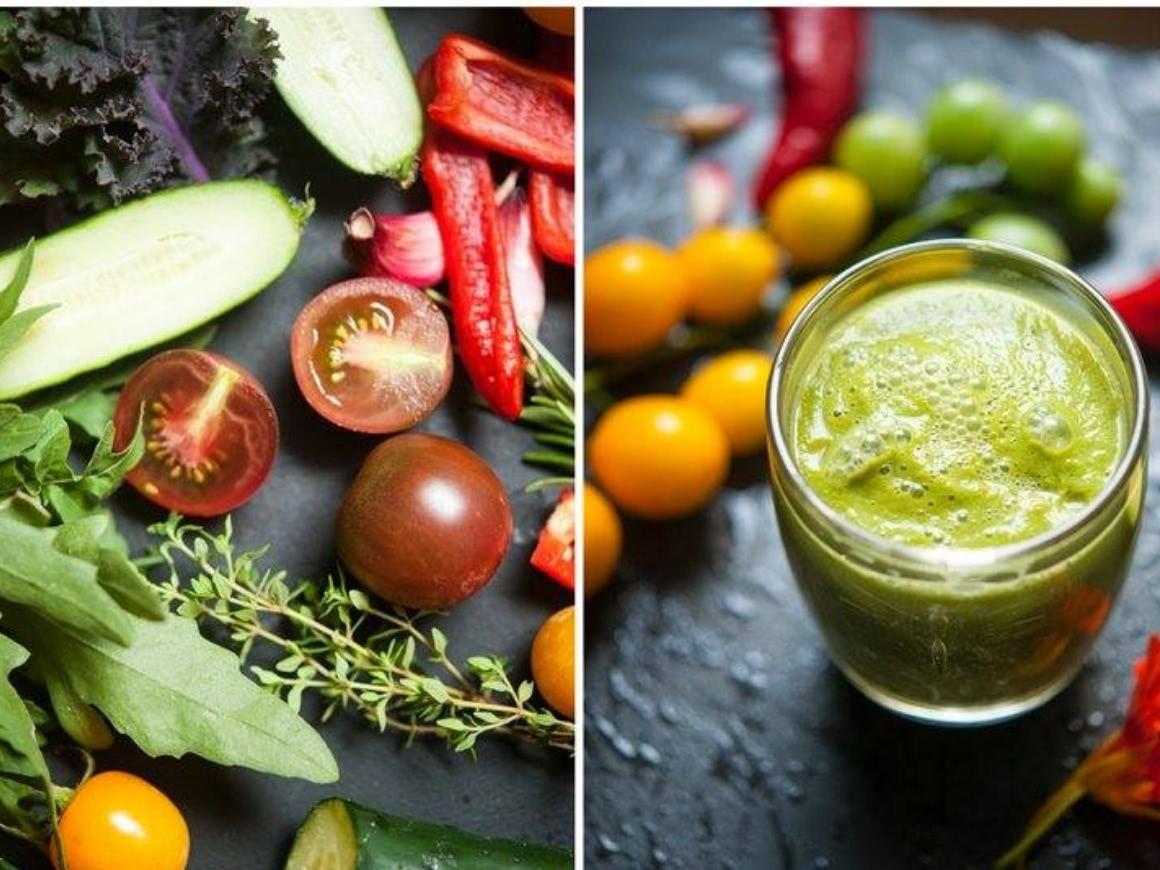
Dried fruits: for sweetening or as a topping
Dried fruits such as dates, figs and mulberries are especially suitable for sweetening a green smoothie, as they are very rich in fructose. About 1-2 medjool dates can replace a whole banana. You can also use dried fruits as toppings for green smoothies. Simply cut them into small pieces and garnish your smoothie with them. This stimulates the chewing reflex and ensures that the smoothie is not misunderstood as a thirst quencher. However, most commercially available dried fruits are heated. We therefore recommend to always look for organic quality when buying dried fruits.
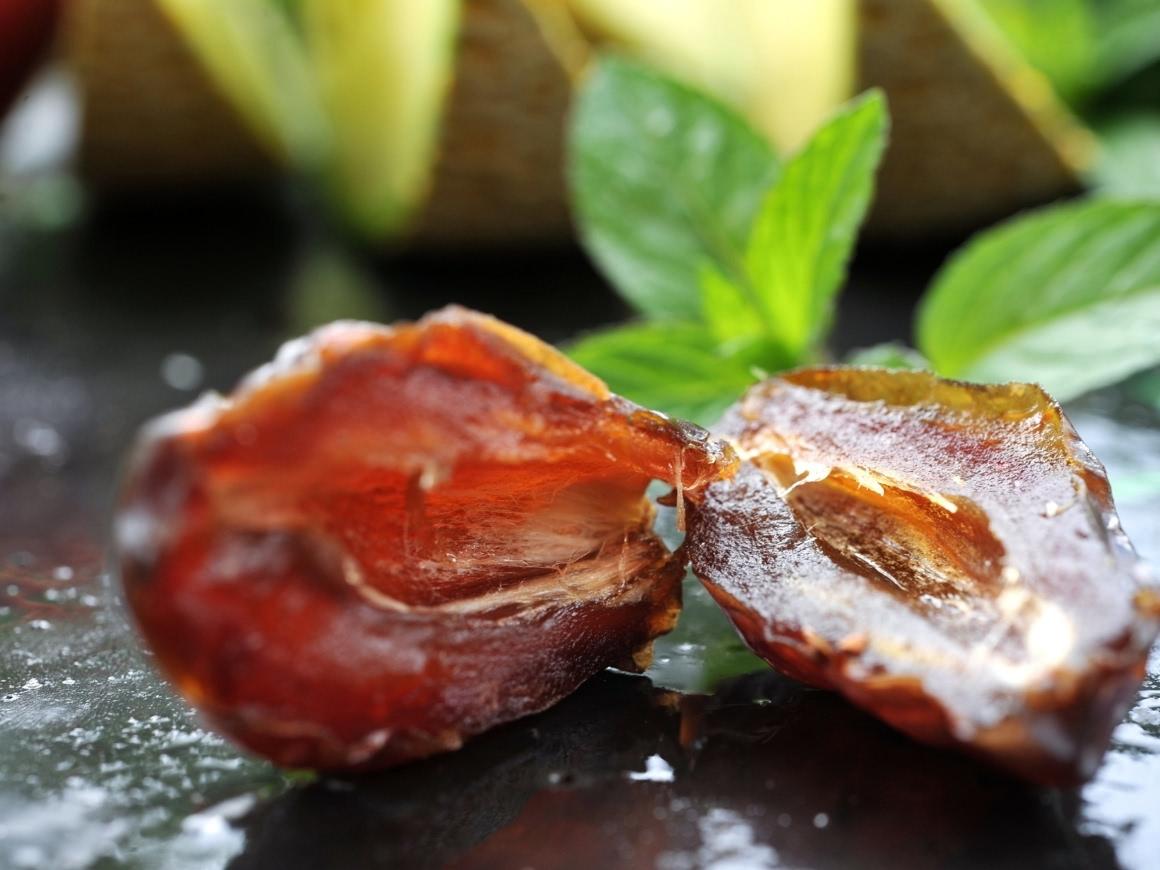
Water and other Liquids in Green Smoothies
Use water that is natural quality and tastes good - such as still mineral water, fresh spring water, or filtered tap water (e. G., with an activated carbon filter). Carbonated water is not recommended, as it interferes with the alkaline effect of Green Smoothies. Alternatively or additionally (depending on consistency and taste) you can also use freshly squeezed juice, such as orange juice.
It is important not to use ready-made juices or highly heated coconut water bought in the supermarket. Both inhibit the the green smoothie's alkaline effect and its easy digestibility.
Warming spices in Green Smoothies
This is how green smoothies turn into warming pleasures
Especially in the cold season, the need for warmth is not only for typical for "Vata" types (Vata is a dosha in Ayurveda - people who are particularly "sensitive to cold“), but also for all others who like it warm and cozy.
With spices that have a warming effect, Green smoothies can also be (heart) warming in the dark and cold season.
Two things first:
- All spices, without exception, represent a flavor-enhancing ingredient; they are (important) supporting actors. No more, but also no less!
- You'll find (very) good green smoothie ingredients matching each spice.
Anise
Background
Egyptians, Greeks, Romans, Arabs - they all knew and appreciated: anise.
Anise is a light-loving plant that needs a warm and humid, i. e. subtropical, climate during its growing season. It's no surprise that it's mainly grown in the subtropical areas of Southeast Asia, Central and South America. Originally, anise comes from Asia.
In the Middle Ages, there were attempts to cultivate anise north of the Alps - despite the non-existent subtropical climate in these regions. However, to achieve the full flavor of anise, it needs this subtropical climate! Therefore the attempt was not really successfull...
Use
The typical anise flavor is determined by its essential oils. It is intense, has a warming effect and goes perfectly with fruits, fennel and ginger. This also is the reason why it does well in green smoothies - and not only in bread, baked goods and spirits (ouzo, absinthe, pastis, aguardiente).
Anise goes very well with: pineapple, apple, pears, dates (dried), fennel greens, fennel seeds, fruits, ginger, cardamom, all kinds of cabbage, melon, nutmeg, oranges, pepper, plums, vanilla, cinnamon, lemon.
Effect
Anise was and is used not only as a spice, but also as a medicinal plant. It has expectorant-, digestive-, antiseptic- and antispasmodic-effects. Furthermore it stimulates the appetite.
Ginger
Background
The classic. Nothing warms more than fresh ginger. More precisely: a fresh ginger root. Ginger grows in the tropics and subtropics. Its origin is believed to be in Asia or India. Fittingly: The largest producer is India (about 250,000 tons per year), the largest cultivation area is in Nigeria and the largest exporter is China (source: Wikipedia).
As different as the growing regions are, as different is the taste: ginger always tastes somehow fruity and somehow hot - and yet: depending on the kind and growing region, the taste differs significantly. Common to all ginger varieties is the "Spiciness".
The spiciness, by the way, comes mainly from the secondary plant substance gingerol.
Use
Ginger always looks good in a green tea, especially in winter! It can easily be used "twice": both in tea, as well as in green smoothies. Ginger is the spicy-warm base component!
For all those who like ginger: Ginger is able to really enrich any green smoothie, both taste and health wise!
Ginger goes very well with: Pineapple, anise, apple, apricots, dried fruit (date), basil, pear, chili, cranberries, strawberries, figs, fennel greens, grapefruit, raspberries, persimmon, cardamom, carrot greens, coriander, coriander greens, turmeric, Lime, Mangoes, Melon, Mint, Nutmeg, Orange, Papaya, Peppers, Peaches, Allspice, Raisins, All lettuces, Celery, Tomatoes, Vanilla, Cinnamon, Lemon, Lemongrass, "lemony" garden herbs (e.g lemon balm), citrus fruits.
Flavor combinations: Ginger + celery, ginger + apple + dried fruit (date), ginger + coriander greens + green Asian salads, ginger + lemon + mint.
Effect
Ginger does its job well. While Western science is still in the process of identifying individual substances that are supposed to be responsible for one or another effect, asian medicine, which after all looks back on a tradition of more than three thousand years, is sure about the following: Ginger has antioxidant (reduces oxidative or nitrosative stress), antiemetic (helps with nausea and vomiting), anti-inflammatory, digestive (stimulates the formation of gastric juice, saliva and the intestinal function), expectorant, anti-diarrheal, antipyretic (reduces fever), antibacterial, antiviral and blood purifying. No wonder it was traditionally used for rheumatism, muscle pain and colds!
Chili
Background
Chili belongs to the bell pepper family, which is easily recognized by its shape. What distinguishes chili from bell pepper is its spiciness. The spiciness in chilies is caused by the (plant) substance capsaicin, which causes a heat stimulus by affecting specific receptors (only in mammals). Capsaicin is contained in every type of pepper, but particularly high levels are found in chilies - most of it, incidentally, in the so-called "habaneros".
Capsaicin causes a burning feeling on mucous membranes of all kinds, not only in the mouth, but also in the eyes - it's this burning that we commonly perceive as "hot."
Use
One or the other may be surprised, but chili (powder) - also called cayenne - fits in a variety of green smoothies. The individual sense of taste makes the decision. The following statement is therefore more to be understood as well-intentioned advice.
With chili, the dosage is particularly important. It makes - as everywhere - the difference! A "pinch" of chili can turn a good smoothie into an excellent green smoothie. Chili fits perfectly in "sweet and sour" and rather "bitter" smoothies.
Chili goes very well with: pineapple, avocado, basil, dates, fennel, fruits (esp. citrus), kale, ginger, coriander, coriander greens, lime, pepper, parsley, tomato, cinnamon, lemon, lemongrass and salads of all kinds (radicchio, arugula).
Flavor combinations: Chili + coriander green + lime
Effect
Chili increases the production of oral saliva and gastric juices - therefore promotes digestion; increases peripheral blood circulation; cardiac activity; antiseptic-effect (i. e. reduces germs - the reason why chili is traditionally added to dishes, especially in regions around the equator); hemostatic-effect; sputum-promoting and generally stimulating.
Cinnamon
Background
Cinnamon is obtained from the dried bark of cinnamon trees. If it's a "real" cinnamon tree - Ceylon cinnamon tree - the cinnamon is then called "Ceylon cinnamon". This tree originally stood on the island of "Ceylon", today's Sri Lanka, where it was discovered by the Portuguese navigator Vasco da Gama. He brought the cinnamon to Europe and traded it for a lot of money.
The main cultivation area still is Sri Lanka today.
The wonderful, aroma of the cinnamon tree is primarily due to the cinnamon oil it contains.
Use
The key to cinnamon lies (as so often) in the dose - a balanced relationship between its (potentially) dominant flavors on the one hand and the flavor nuances of other ingredients on the other hand. When these two are harmoniously matched, it results in an incredibly good taste
I like to use cinnamon with cabbage and rather sweet green smoothie ingredients.
Cinnamon goes very well with: apple, apricots, bananas, berries, pears, chili, fennel greens, fennel seeds, all fruits, blueberries, ginger, cardamom, all cabbage varieties, coriander greens, coriander seeds, turmeric, nutmeg, orange, peppers, raisins, all types of lettuce, tomatoes, lemons.
Effect
Cinnamon is not only one of the oldest spices, it is above all one of the oldest medicinal herbs on the planet. Cinnamon has diaphoretic, carminative (digestive), general healing, diuretic (promotes water excretion), expectorant and analgesic effects.
Cardamom
Background
The following paragraph is about green cardamom and not about black cardamom .
Cardamom originally comes from southern India, Sri Lanka, Iraq and Thailand. These still are the main cultivation areas today.
The most interesting thing about cardamom is hidden well-protected in the triple, straw-like capsular fruits. Each of these compartments holds four to eight gray-brown seeds, it is these seeds that we are interested in. They contain an essential oil, which gives cardamom - similar to anise - its characteristic taste: sweetish-pungent and spicy-fresh.
(In contrast to black cardamom, green cardamom has a rather tart, earthy aroma)
Use
However, only the seeds are aromatic. We cannot recommend the commercial powder, it just isn't sufficiently aromatic. This is due to the fact that the flavorful seeds are grinded together with the tasteless fruit skin.
Of course, you can also buy the capsules separately.
Good cardamom can be recognized by the fresh green color of the capsules and the oily black color of the seeds.
Cardamom goes very well with: anise, apple, apricots, bananas, pears, chili, date (dried), grapefruit, ginger, all cabbage varieties, coriander greens, coriander seeds, orange, peppers, all types of lettuce, spinach, vanilla, cinnamon, lemon, citrus fruits.
Effect
The seeds have carminative (help digestion and relieve flatulence), diaphoretic and appetite stimulating effects. They also clean the oral cavity and specifically counteract bad breath.
Turmeric
Background
Turmeric is a plant belonging to the ginger family, which originally comes from South Asia. That is why turmeric is also called "yellow ginger". It is mainly cultivated in tropical regions.
Unlike ginger, the "pulp" of the root / tuber ("rhizome") is bright yellow / orange. This bright yellow-orange "pulp" can be used fresh or dried as a spice and dye (e. G. in curry powders). Especially fresh turmeric is an excellent dye. Similar to beet, but much more "persistent" in its effect: once yellow, (almost) always yellow!
Responsible for this penetrating yellow color: curcumin. Turmeric also contains several essential oils. The extraordinary healing effect of turmeric is attributed to the combination of these two substances - together with several hundred other unidentified secondary plant substances. The professional term commonly used for this is: "nutritional matrix".
Use
First of all: fresh, organically grown turmeric is rather hard to get. If you are lucky, don't hesitate to make the purchase! You will be surprised!
1-2 knife tips of dried turmeric powder enrich almost every green smoothie. Since turmeric is able to miraculously "round off" the flavor, it goes great with almost any flavor combination. As usual as always, it depends on personal preference.
Turmeric acts similar to a "primer". By the way, this is the reason why it is always one of the first spices that goes into a curry. The amount of turmeric used, determines the taste the curry will have at the ende...
Turmeric goes very well with: chili, curry, fennel greens, fennel seeds, all fruits, ginger, all cabbage varieties, coriander greens, coriander seeds, paprika, parsley, bell pepper, all types of lettuce, spinach.
Flavor combinations: Turmeric + coriander greens + cumin + toamte + paprika + parsley + bell pepper.
Effect
Turmeric is considered an extremely potent remedy, especially in Ayurveda and TCM. It acts as a natural septic agent, not only "beautifies" the skin, but is also able to cure chronic skin diseases such as leprosy. It helps with diabetes, diseases of the urinary organs, impure blood, anemia and ulcers!
Coriander
Background
First of all, we're not talking about the equally fantastic green plant, today we introduce you to the spice of this plant, more precisely its seeds.
Coriander is ancient. It is probably one of the oldest spices known. First (written) proofs are found 6000 before Christ! The ancient Egyptians, Indians and Chinese knew and used coriander mainly for medicinal purposes and as a spice. Today, the plant is cultivated in Central, South and North America, but also in Africa, Asia and Europe.
Use
Since we are talking about coriander spice today, we focus almost exclusively on the seeds. These get their typical nutty, spicy-woody, slightly sweet taste from the special process of storage and drying.
(The green parts of the plant taste "completely" different. They have a taste of their own, the exceedingly strong, sharp-bitter aroma prevails - which perfectly fits into the South American and the Asian kitchen)
Coriander seeds are suitable as ingredients for green smoothies whenever things get "extravagant", i. e. when "Mediterranean" or "Oriental-Asian" flavors are in the foreground.
Coriander seeds go very well with: basil, fennel greens, fennel seeds, chili, fruit, dried fruit (date), kale, ginger, cardamom, coriander greens, turmeric, mint, nutmeg, orange, orange peel (grated), pepper, allspice, spinach, tomato, wild herbs, cinnamon.
Flavor combinations: Coriander + cardamom + cinnamon, coriander + chili (cayenne pepper) + cumin + garlic, coriander + chili peppers + mustard seeds + black pepper, coriander + cumin + curry.
Effect
Coriander seeds have antiseptic, i. e. germ-reducing, expectorant, diuretic (promotes urination), aphrodisiac and help - as well as the green parts of the plant - against gastrointestinal upset, flatulence and bloating.
Nutmeg
Background
The name "nutmeg" is confusing - it suggests that nutmeg is a nut. This, however, is wrong. The nutmeg is the seed of the nutmeg tree. It is surrounded by an oily seed coat. Both the kernel of the seed and the seed coat are used as a spice. While the seed is called nutmeg, the seed coat is called nutmeg-flower or mace.
The nutmeg tree loves tropical climates. It is cultivated throughout the tropics: in Asia, South America and Africa.
Use
Nutmeg in a green smoothie? That sounds a bit unusual at first - and it is. Nevertheless, every now and then there is nothing to say against it. The exact opposite is the case: Properly dosed, its fiery sweet and very aromatic spiciness is perfectly expressed and complements all spices that emphasize this flavor.
Hildegard von Bingen is said to have said the following sentence: "Nutmeg has great warmth and excellent powers. Its consumption opens the heart of man and purifies his feelings and provides him with good sense."
Nutmeg goes very well with: apple, berries, pear, all kinds of fruits - fresh and dried, kale, honey, ginger, cardamom, all cabbage, carrot greens, coriander, cumin, oranges, pepper, all salads, spinach, cinnamon, lemon.
Flavor combinations: Nutmeg + allspice + cinnamon, nutmeg + ginger + white pepper + spinach.
Effect
Nutmeg has digestive, anticonvulsive (effects against convulsions), mucus-reducing, expectorant, cardiotonic (supports the cardiovascular system), antiemetic (effective against vomiting), liver metabolism stimulating, antidiarrheal, menstrual, antipyretic (fever reducing) and aphrodisiac effects. It has been attributed with analgesic and soporific effects. It was (and is) used both internally and externally, e. G. for rheumatic complaints, excema and lichen.
Pepper
Background
Another spice that comes from the far Orient, more precisely: India. Pepper cultivation only reached what is now Indonesia, Vietnam and Malaysia, as Indian culture spread to Southeast Asia - in the meantime, the most important areas for the cultivation of the pepper plant today.
When we talk about "pepper", we usually mean black pepper, which is also the subject of the following. There also is green pepper, white pepper and red pepper. All four types of pepper are produced by the same pepper plant. The different colors come from the different degrees of ripeness and the different processing methods:
- Green pepper is made from unripe, early-harvested fruit, which is then pickled in salt water or dried at high temperatures.
- Black pepper is made from fruits just before ripening, which are then (air-)dried.
- White pepper is made from fully ripe red fruits that are soaked under running water, peeled, dried (by the sun) and then bleached.
- Red pepper is the actual ripe pepper-or rather, the ripe fruit of the pepper.
Essential oils and the spicy taste of piperine stand out among the substances in pepper.
Use
Pepper can be used in many smoothies, especially in spicy or sweet-sour smoothies that already have this flavor - a pinch of pepper rounds it all off.
A pinch of pepper is quite sufficient here. However, this pinch fits conveniently to almost everything! Especially fruits enjoy a peppery note!
Tip: Simply add pepper after the blending process, this peps up the "Grüni" just before serving it!
Pepper goes very well with: pineapple, basil, berries, pears, fennel greens, fennel seeds, cardamom, all cabbage varieties, coriander greens, coriander seeds, mint, parsley, all types of lettuce, tomato and all wild herbs.
Effect
Ayurveda and TCM consider pepper to be one of the most important substances for stimulating digestion! It has an expectorant, appetizing, antipyretic and antiparasitic effect.
Paprika
Background
Everything starts small. It is no different with the bell pepper. What nowadays can be bought as "bell pepper" is the (clearly) bigger "tuned" "brother" of a large number of much smaller and hotter "relatives". Actually, they can also be called "parents", as these small peppers have made the cultivation of the yellow red and green peppers, known to us today, possible. While the parents were small and hot (chilies and peperonis), the children are large and mild - which is due to the amount of the (secondary) plant substance capsaicin responsible for the hotness.
Peppers have their origin in the tropical jungles of Central and South America. It was the indigenous Indians who began to cultivate the consistently hot fruit several thousand years ago.
Use
Since we are talking about spices in the context of this article, we will not be referring to the bell pepper as a whole, but to the paprika powder obtained from it. There are diffenrent degrees of spiciness, depending on the peppers that are used. The range varies from mildly-sweet and fruity to sharp-spicy powders. What they all have in common is the (soothing) warming effect!
Paprika powder is particularly good whenever a sweet-hot flavor is to be deepened or intensified. Especially "Mediterranean" and "Oriental-Asian" creations benefit from it. As always, the dose makes the difference!
Paprika powder goes very well with: chili, curry powder, dried fruits (date), kale, ginger, all types of cabbage, cardamom, turmeric, peppers, parsley, pepper, allspice, radicchio, arugula (rocket) tomato, wild herbs, lemon.
Flavor combinations: Bell bell pepper + berries + date.
Effect
Paprika has a positive effect on the cardiovascular system, it alleviates circulatory disorders and helps with digestive problems (anticarminative). Fresh, but also gently dried paprika powders also have an enormously high vitamin C content. However, this applies exclusively to the dark red variant.
(A little advice: stay away from green peppers, they are simply unripe)
Shopping for green smoothies ingredients
When shopping, the most important thing is to look for fresh leafy greens and ripe fruits. Both of these criteria are crucial to ensuring that your green smoothie not only tastes great, but can provide its full range of nutrients. Leafy vegetables, start to lose vital nutrients unceasingly as soon as they are harvested. While you can recognize fresh leafy greens like lettuces and herbs by the fact that they are full of tension and simply not wilted, there are a few things to keep in mind when buying fruits. We have therefore compiled our most important tips.
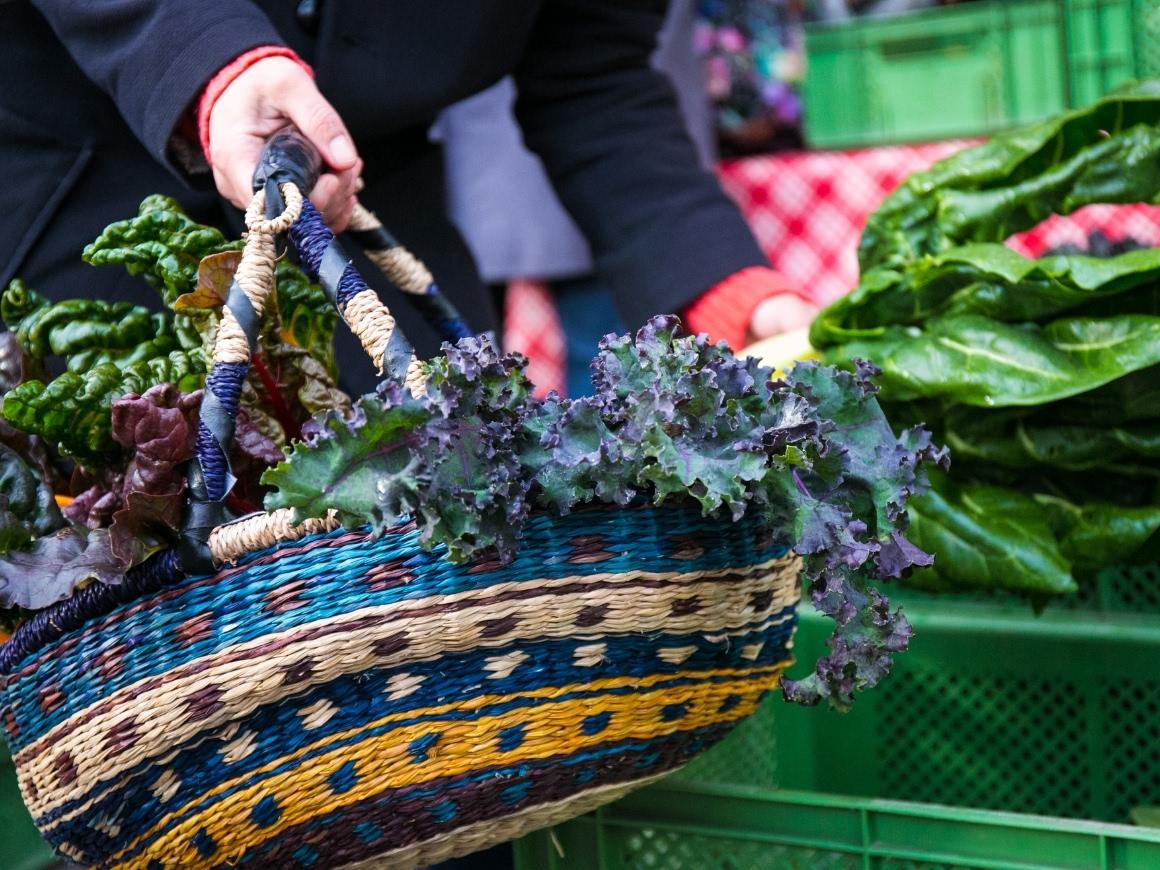
Pay attention to organic quality
We prefer organic markets for shopping our smoothie ingredients. They provide us with an abundant supply of fruits and leafy greens, especially in the winter. In any case, we recommend to pay attention to organic quality especially when buying leafy greens. This is the only way to avoid toxic residues of pesticides. After all, you can't even peel lettuce, cabbage or parsley. If you want to process the peel of the fruit, our clear recommendation is to buy organic quality. However, it is and remains important that the fruit is properly ripe.
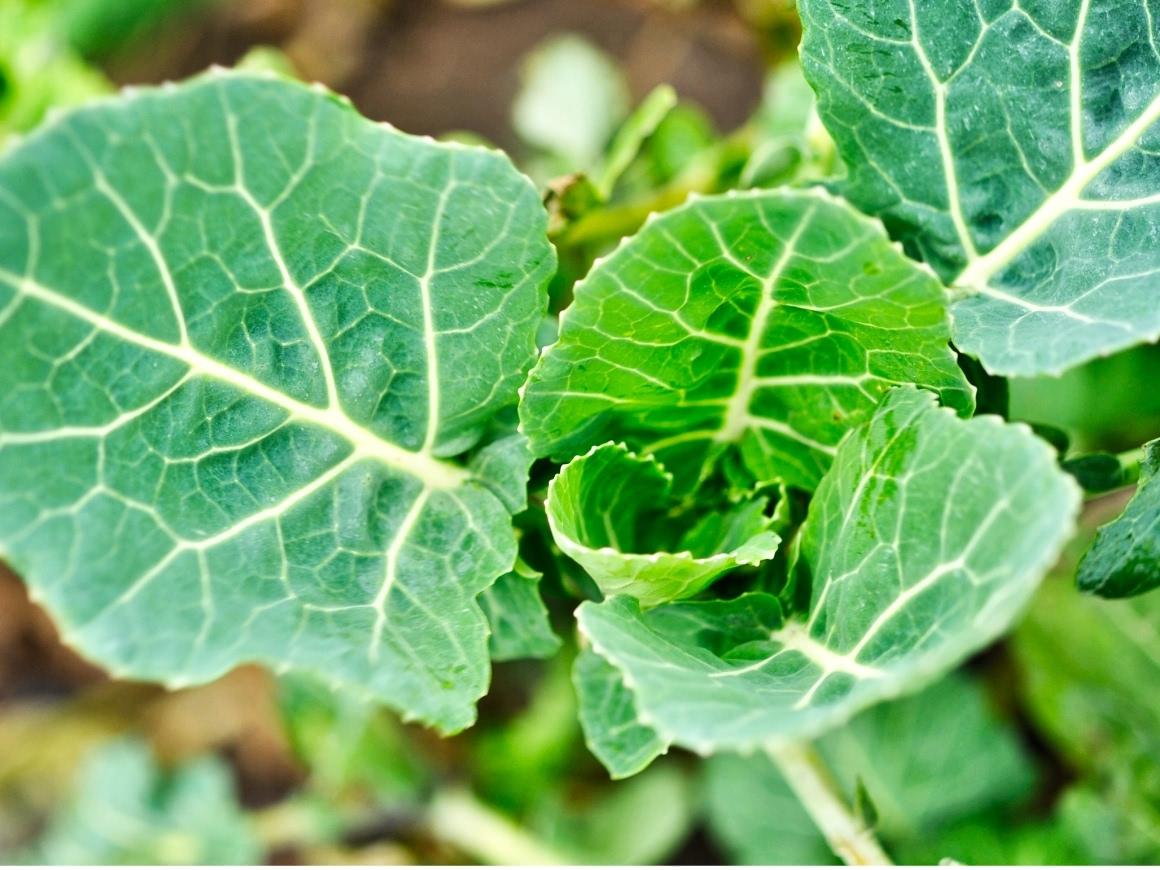
Fresh products from Farmers' markets and directly from the farmer
Regional fresh products can be found on farmers' markets or in the farm store of a farmer. The fruits and vegetables offered are often harvested the evening before or directly in the morning befor they are sold. At farmers' markets you can also get the greens of radishes, beetroot or kohlrabi - (usually) for free. We also find a good selection of wild herbs at Berlin's weekly farmers' market more and more often. If you can't find what you're looking for, ask your trusted farmer to bring you some wild herbs.
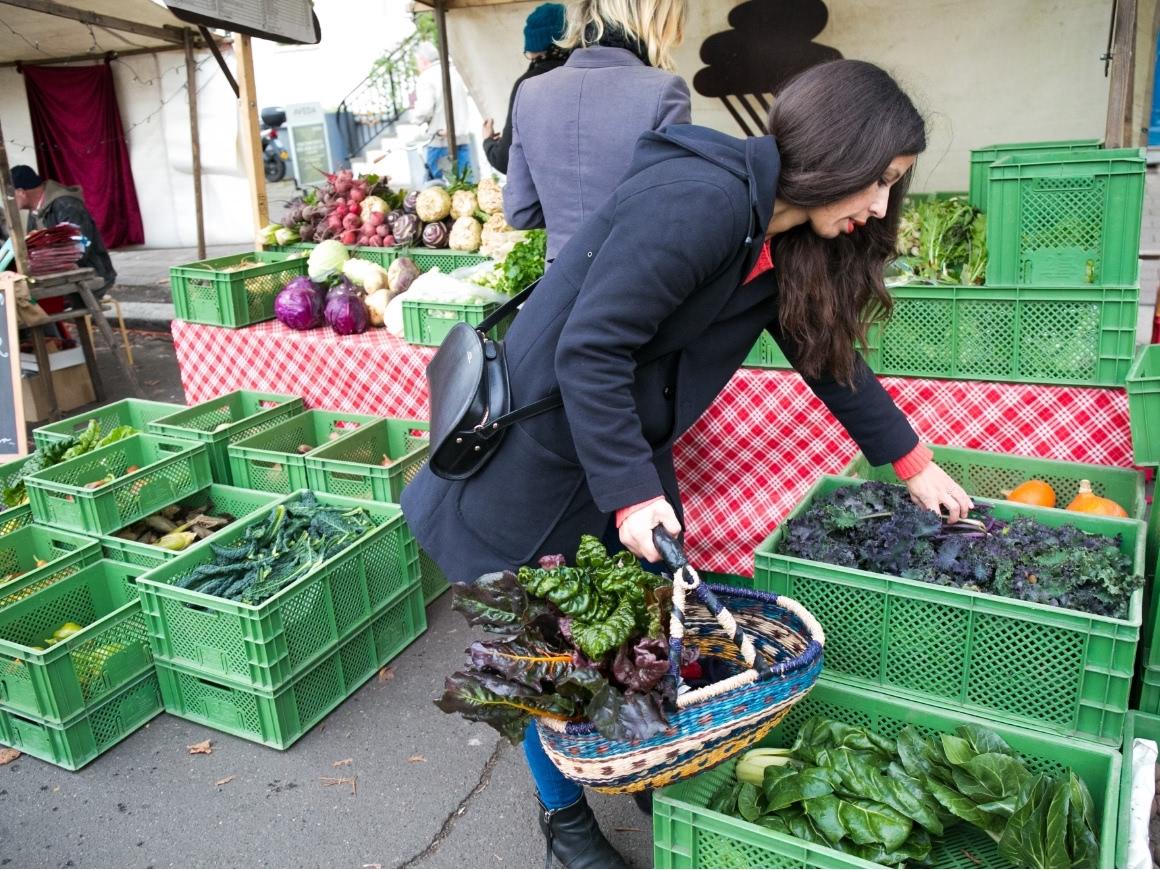
Ripening fruits
When shopping, it is important to know which fruits can ripen at home and which should be purchased ripe. Fruits with the ability to post-ripen can improve their aroma and quality even further - this is the case for tomatoes, apples or avocados. However, even these fruits should not be harvested too unripe, otherwise they can no longer ripen. Perhaps you have had this experience with a rock-hard mango or nectarine that did not ripen but rotted from the inside. The following is a list of post-ripening fruits and vegetables:
- Apples
- Apricots
- Avocados
- Bananas
- Pears
- Cherimoya
- Kaki (Persimmon) - must be very soft to eat, otherwise too many tannins that are still in the fruit make consumption impossible. Sharon is a variety of kaki that can be eaten hard, as it is tannin free.
- Kiwi
- Mango and papaya
- Melons except watermelon
- Nectarines
- Peaches
- Plums
- Tomatoes
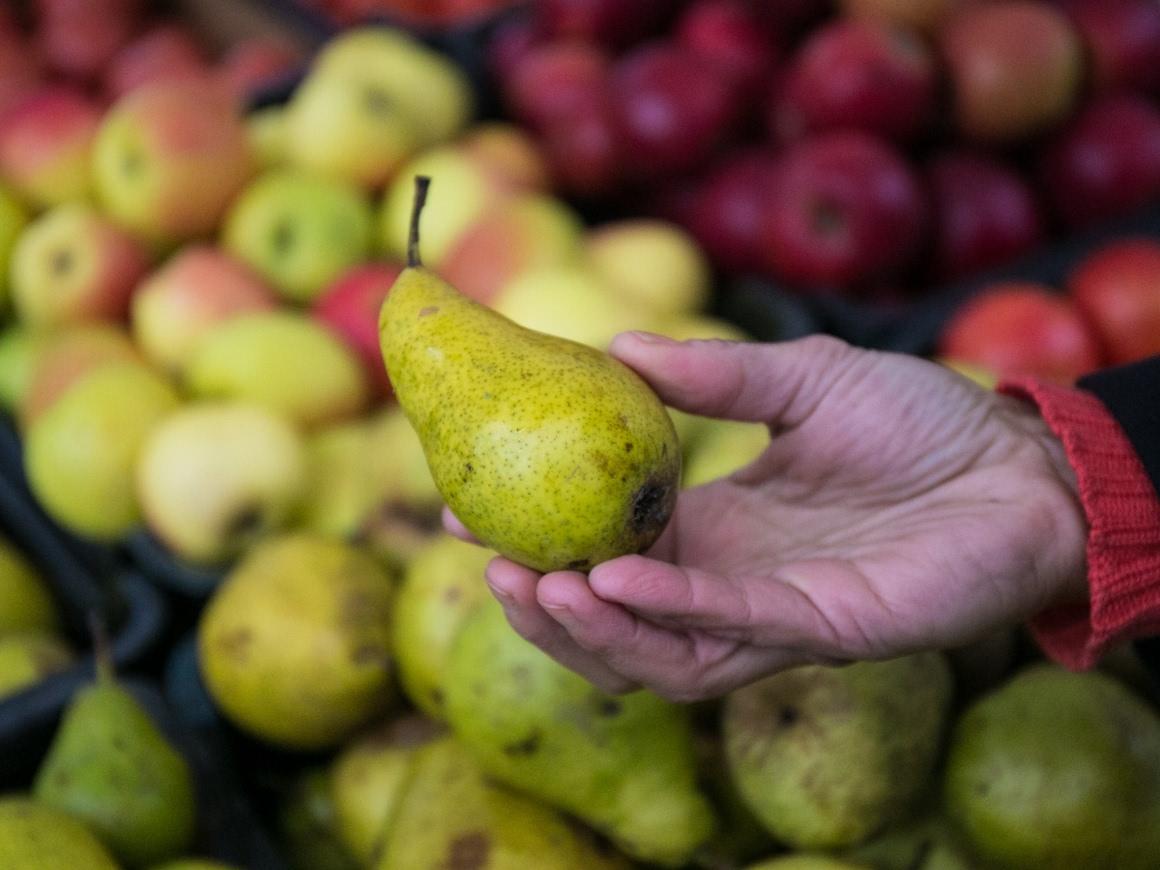
Recognize freshness by cuts, stems and vigor
You can easily recognize fresh ingredients by the cuts and stems of leafy greens and fruits. If these appear dried and woody, the harvest date is a long time ago or the storage methods of the dealer have not been ideal .
With cucumbers, look for elasticity - if they are old, they can be bent without any problems.
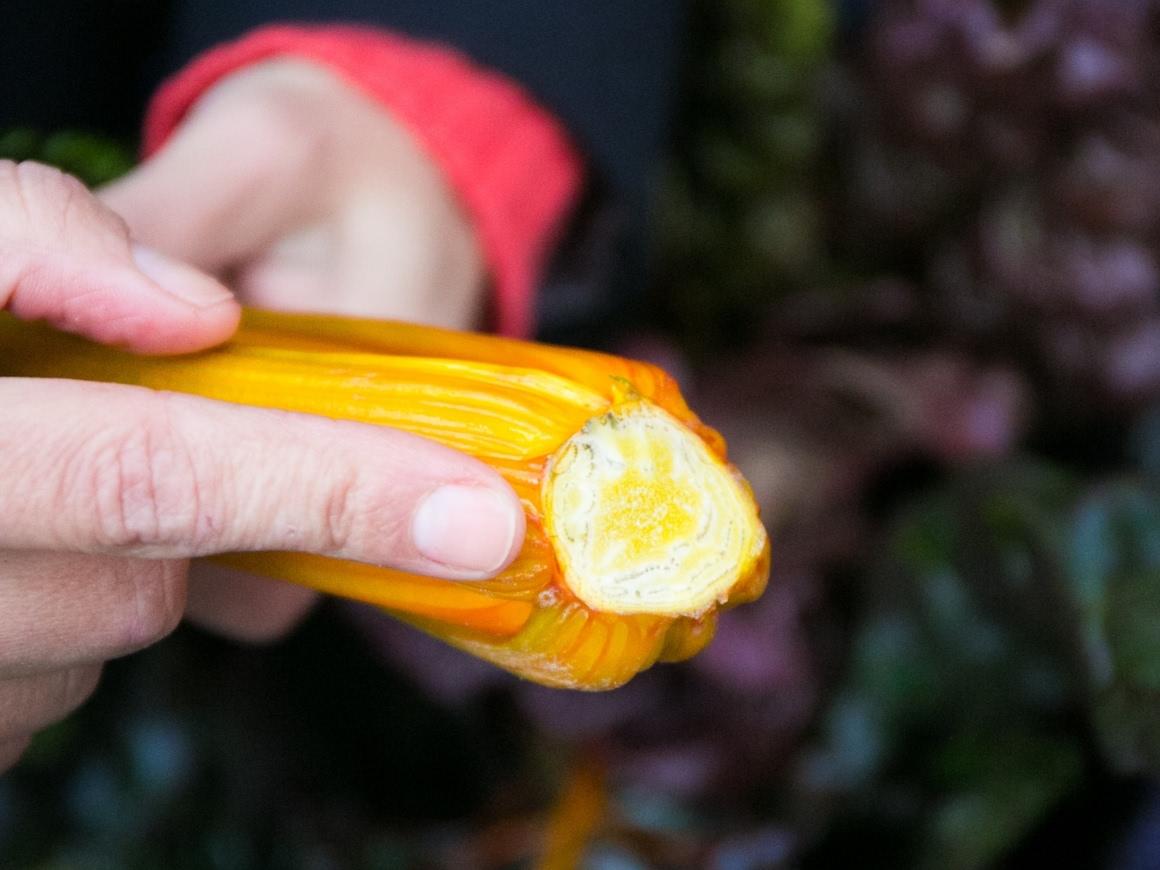
Shiny or dull shimmering: both can be an indicator for freshness
While cherries are crisp and fresh when they are shiny, many other fruits are just the opposite. For example, a dull sheen indicates fresh apples and grapes, whereas shiny apples and shiny grapes are often overlaid. In the case of plums, damsons and mirabelles, the dull shimmering fruits are also much fresher than the shiny ones, as they are still covered by the fruit's own protective layer. This layer evaporates during the storage period - especially if the fruits are stored too cold.
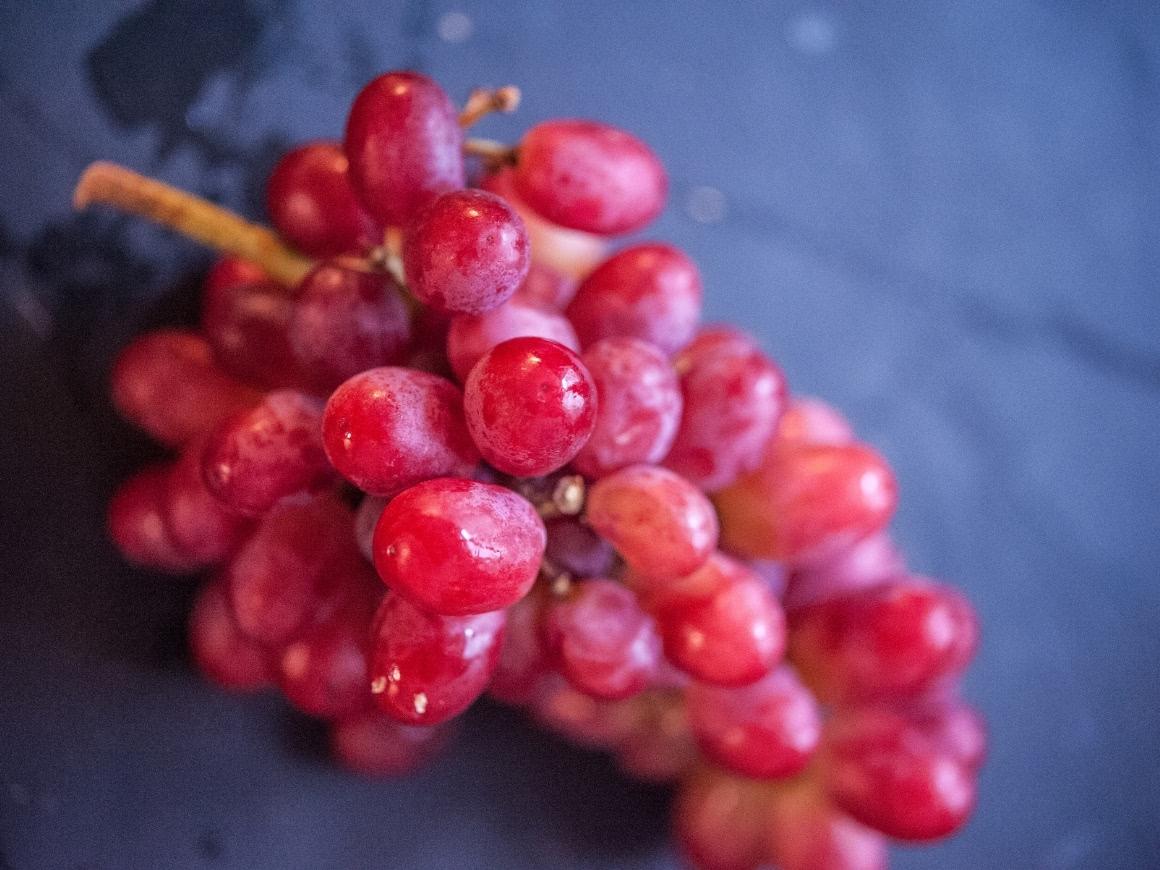
Recognizing untreated citrus fruit
For citrus, a shiny exterior indicates that the peel has been treated. These fruits have been "bathed" in a wax emulsion, with additional fungicides (e. G., thiabendazole), for a longer shelf life. Since we like to use citrus fruits with peel, we strongly recommend you to look for untreated specimens, which are usually only available in organic food stores.
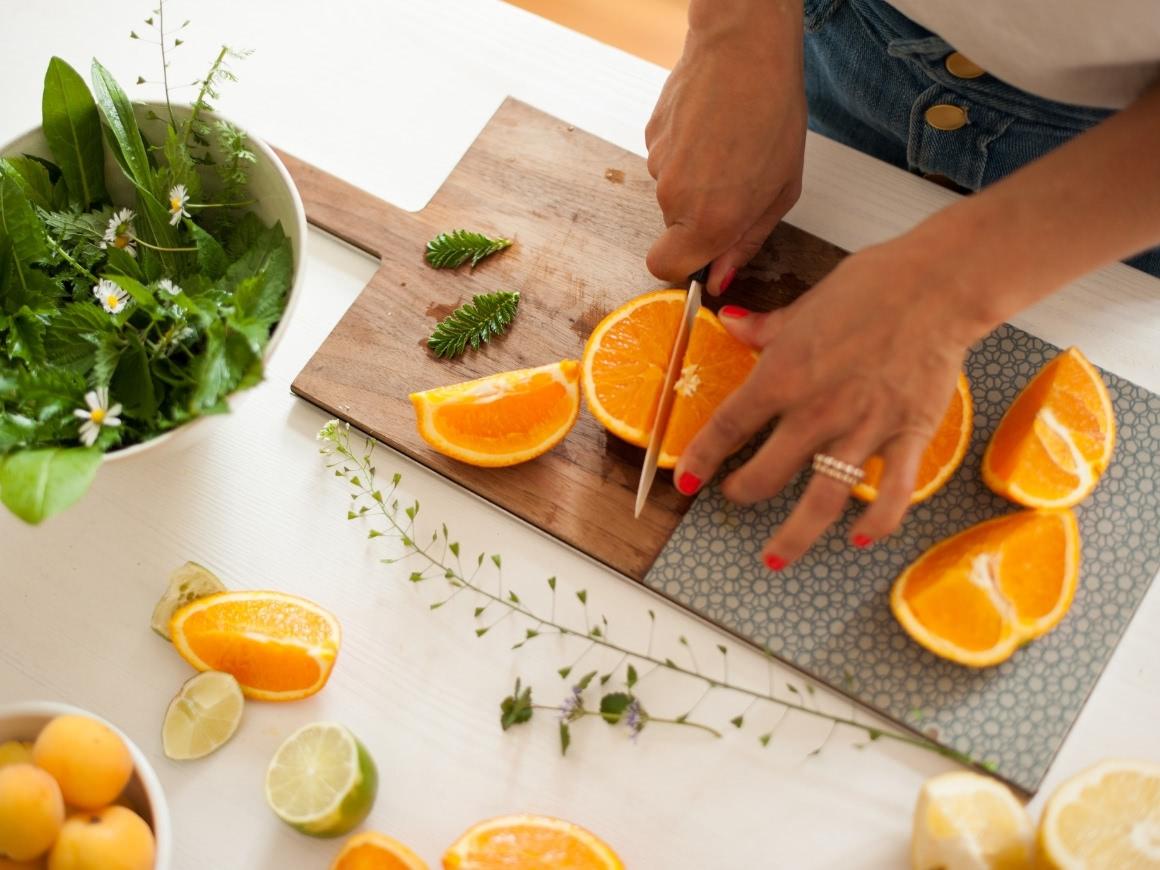
Recognize fresh pineapple
Pineapple is a real flavor booster in green smoothies, but only if it's fresh and ripe. You can recognize a good quality by juicy green leaves, a strong yellow-green colored fruit body and the fine pineapple smell. Also have a look at the cut - it should be mold-free. A well known ripeness test goes like this: If you can pull out the inner leaf of the pineapple without problems, then the fruit is nicely ripe. If not, it was harvested unripe.
Recognize fresh melons
You can recognize well ripened cantaloupe or Galia melons by their smell. Unfortunately, this does not work with honey melons and watermelons. You can ask the dealer to cut the melon open for you or you just gamble. The flesh of the melon is a good indicator of whether the melon is good or whether it is already mushy or woody. We recommend buying watermelons only with seeds and eating them as well. As it is the case with many fruits, the seeds also contain many important nutrients - including. Magnesium, zinc and iron.
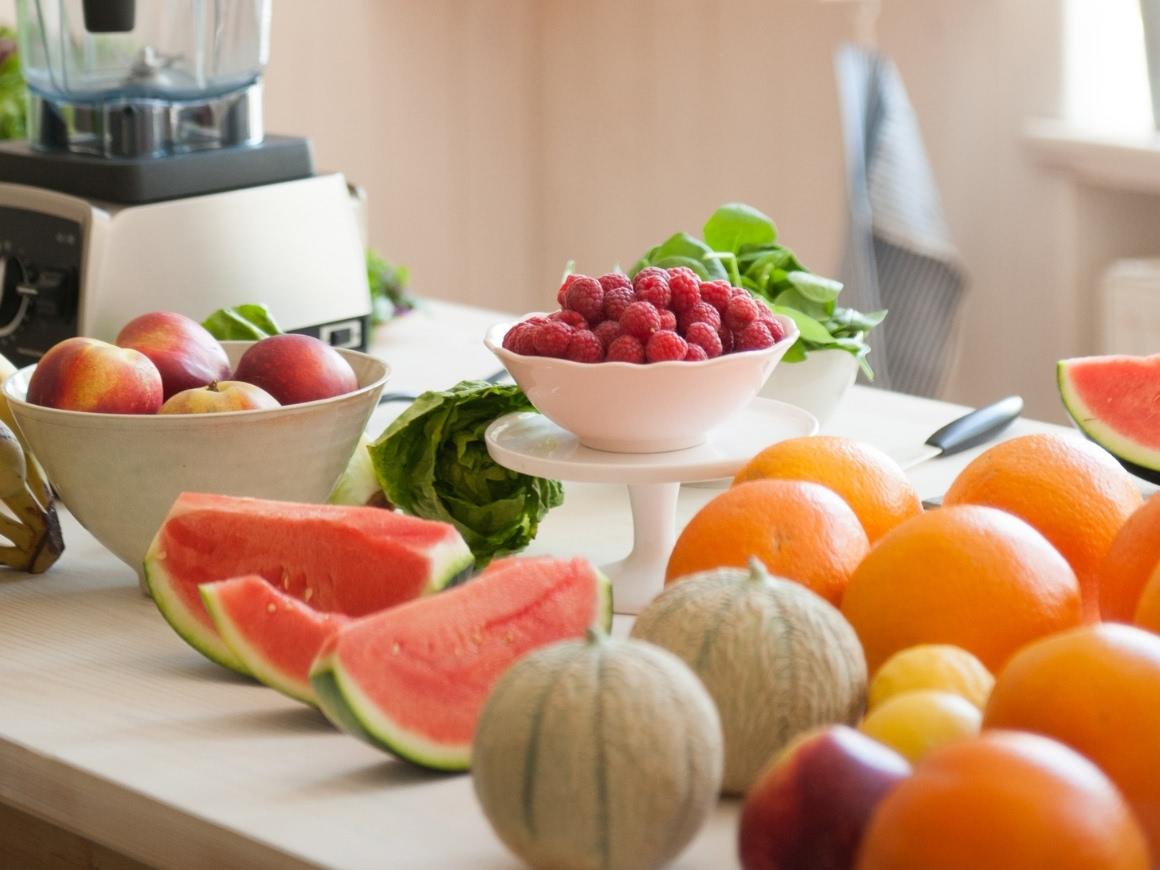
Choose avocado correctly
Hard avocados that ripen at home don't have bruises. However, if you want to buy a ripe avocado, make sure that the avocado still has its small stalk. This should be light brown and still well attached to the fruit. If the stalk is missing or completely dry, then the avocado has been in the store for too long.
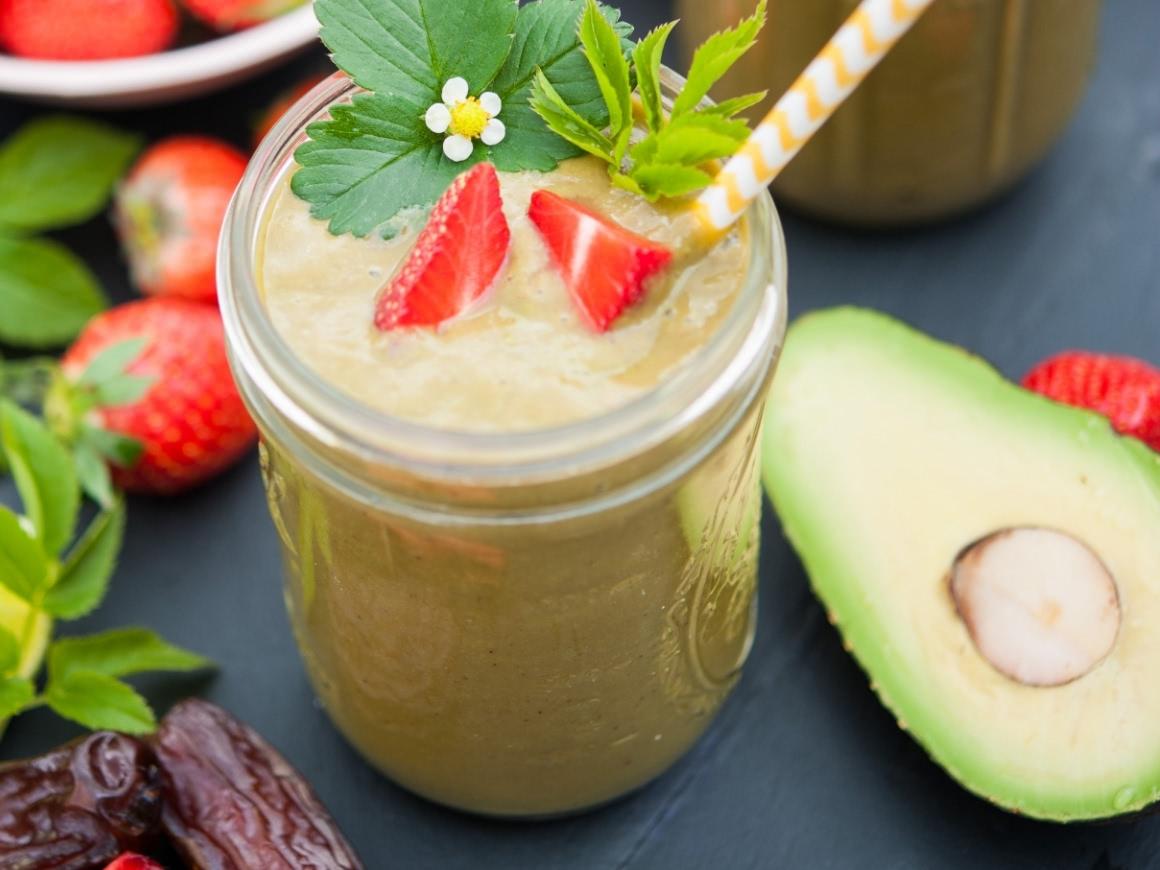
How to properly store Green Smoothie Ingredients in order to keep them fresh
Since you don't always have time to buy fresh ingredients every day, it comes down to optimizing storage of ingredients. Fresh leafy greens can wilt quickly, some fruits quickly rot... but only if you don't store them properly. With a few simple tips, you can make your smoothie ingredients last much longer.
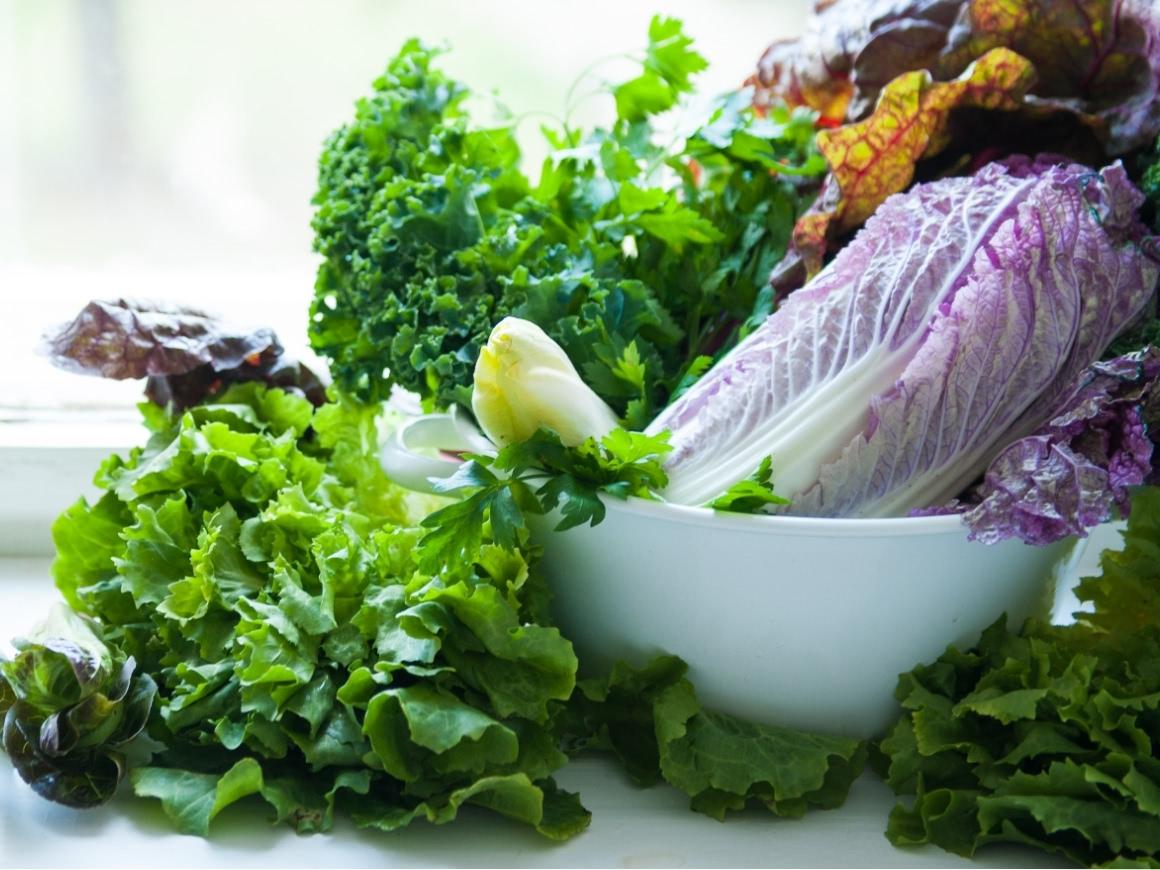
Keep leafy greens moist in the refrigerator
The most important thing when storing leafy greens is that they don't dry out in the fridge. You can prevent this by simply wrapping bulky varieties like kale or chard in a damp cotton towel.
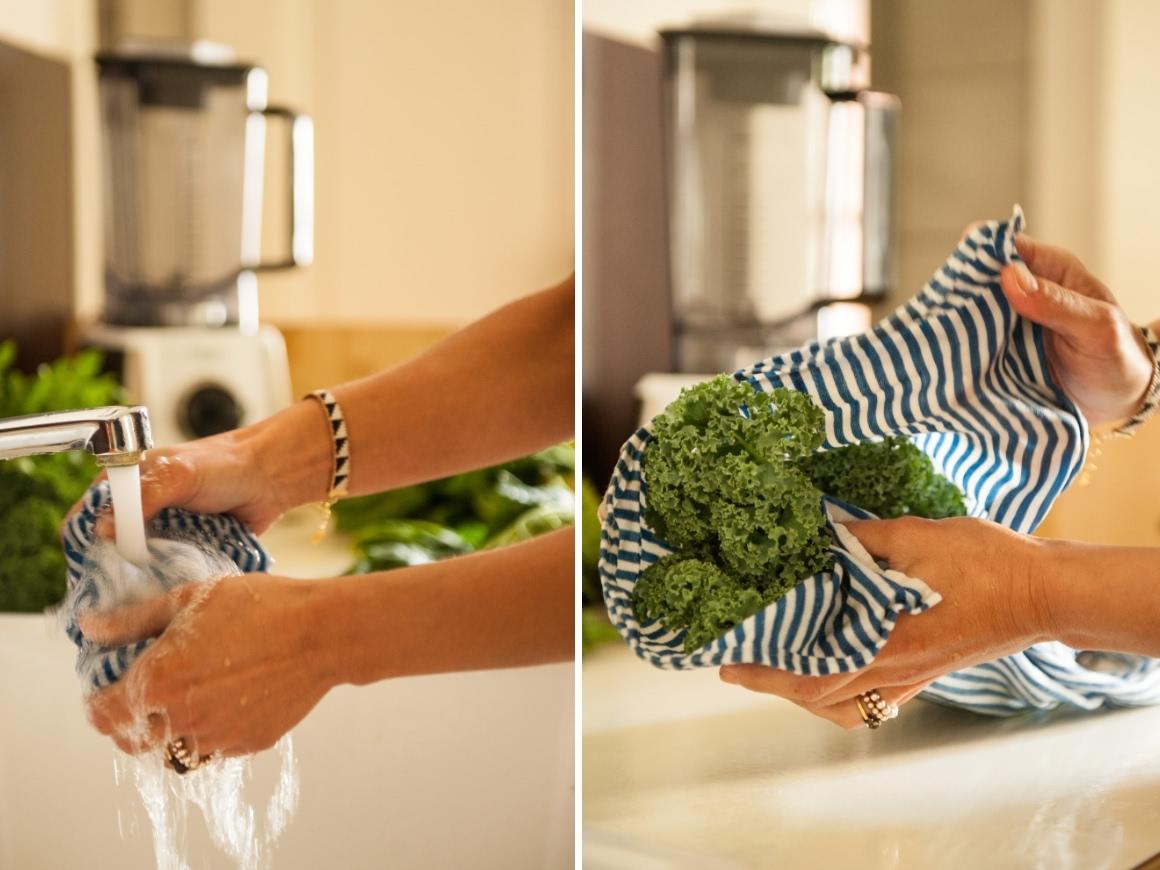
Loose leafy greens like spinach or wild herbs are best stored in storage boxes or corn bags from the health food store (alternatively: plastic bags). Add a few splashes of water. With both methods, you can keep leafy greens in the refrigerator for up to 5 days.
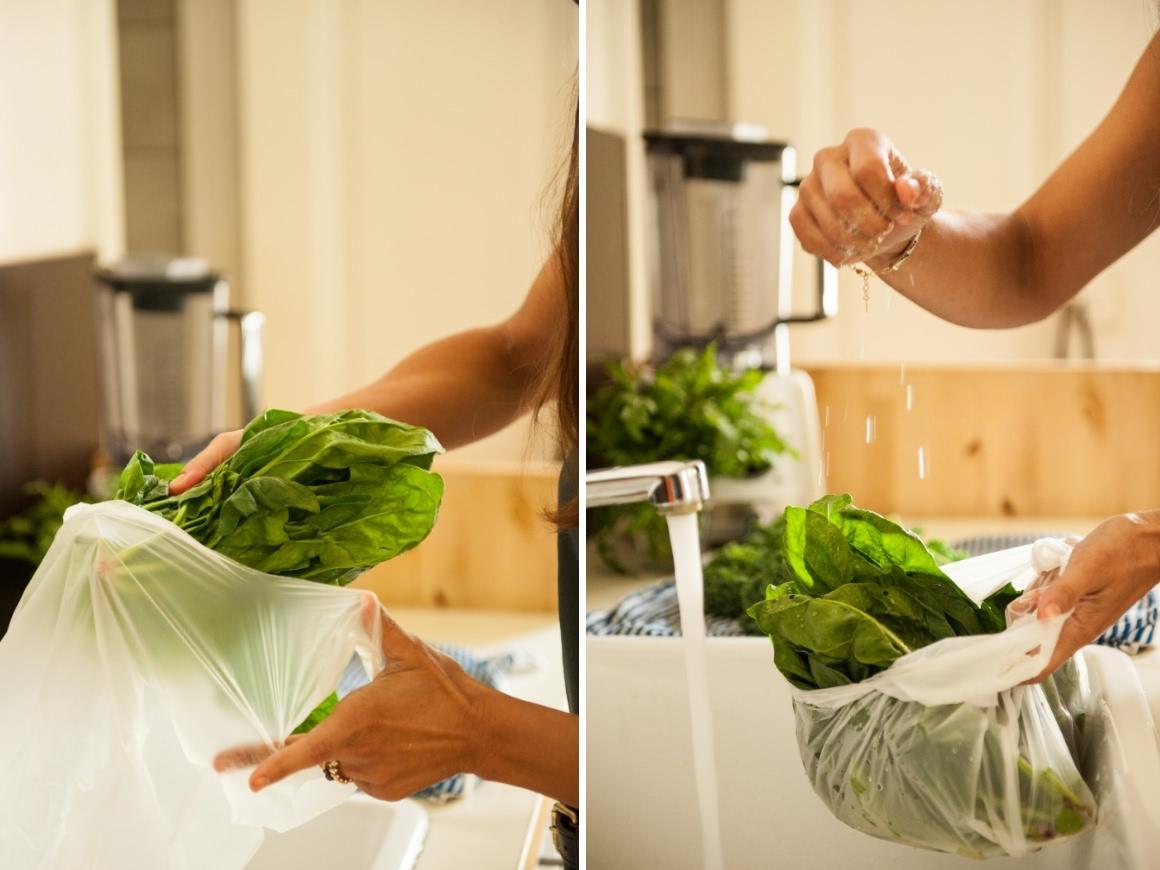
Remove rubber band from garden herbs
With garden herbs like parsley or mint, it's important that you remove the rubber or tape holding them together, as it cuts off the water supply. A splash of water - as described above - then store them in bags or boxes in the refrigerator.
The only herb exception is basil. It gets black cold spots after a short time in the refrigerator - even in the vegetable compartment. Therefore, we recommend always buying basil as a potted plant.
Store fruit and vegetables (fruits) separately
There are a number of fruits and vegetables that give off the ripening gas ethylene - these include: apples and tomatoes. If they are stored together with other fruits that react very sensitive to this gas, such as berries, then these fruits can spoil faster. For other fruits that are not yet fully ripe, this effect can even be beneficial. For example, with hard avocados that need to ripen. Simply wrap them up together with an apple - 2-3 days later, the avocados will be soft.
Domestic pome fruit likes it cool
Domestic fruits like apples and pears are not very sensitive to cold, they are most comfortable in cooler places - a pantry or preferably a cool basement. Apples exhale a lot of ethylene as they ripen, they should be stored separately.
Eat stone fruit and berries fresh
Whether peaches, nectarines or cherries - or raspberries, strawberries, blackberries - stone fruit and berries spoil quickly and should be used as fresh as possible. Stone fruit can ripen at room temperature, but even the small pressure marks quickly lead to rotting. We try not to keep these fruits at home for more than 2 days - when they are ripe, they can be kept in the refrigerator for a short time. Since they do not tolerate moisture well, you should only wash them before direct consumption/use.
Fruits and vegetables that do not want to be stored in the refrigerator
For most fruits and vegetables, only the vegetable compartment in the refrigerator comes into question, as they significantly lose flavor in the cold. For some, the exact opposite is the case: following fruits only belong in the refrigerator - if they are already cut:
-
- Pineapple, mango, papaya, bananas, cherimoya - pretty much all exotic fruits prefer room temperature. Only when they are ripe, they can be kept in the refrigerator for one or two days
- Avocado
- Pomegranates
- Melons
- Tomatoes
- Citrus fruits
Do you have leafy green favorites? What are your favorite green smoothie ingredients?
We appreciate your Feedback here!



























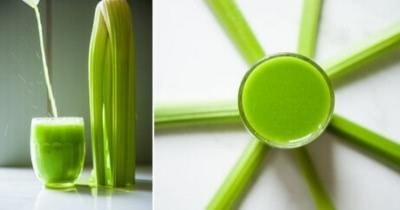
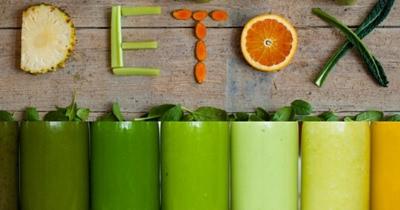

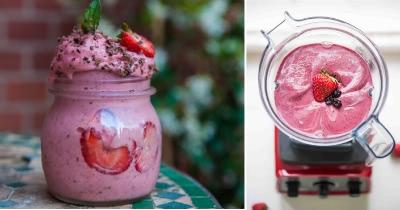

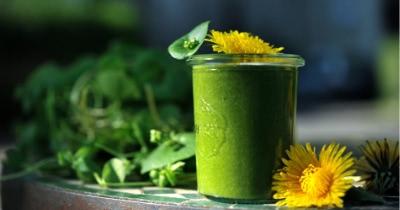
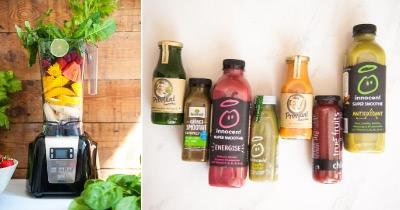

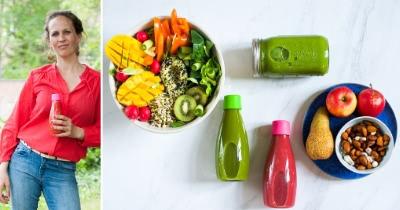




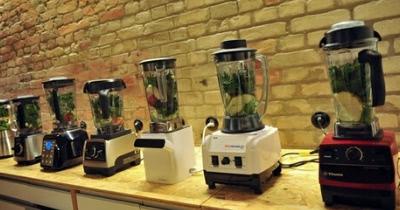
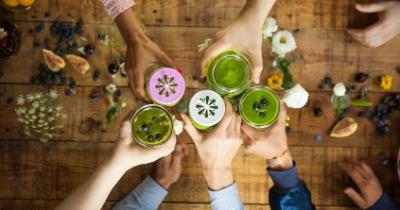





Add comment
36 | Comment(s)
Your recipes are really great.
In the winter, I like to prepare my smoothie with kale, which I have planted in my garden, along with lemon, dates, ginger, a little honey, and a splash of flaxseed oil.
Best regards, Margret...
And you are a very likeable team, your smoothie suggestions are superb and good for health...
Thank you so much for the lovely feedback on our smoothie recipes and for sharing your winter smoothie recipe. We are thrilled!
Wishing you all the best,
Warm regards,
Carla
Thank you both very much - keep up the great work!
thank you for the lovely feedback and for sharing your smoothie ingredients for the winter.
Best regards,
Carla
Little question: do you use Store bought frozen fruits from time to time?
It's unfortunate to hear that you sometimes feel nauseous after drinking smoothies. There can be many reasons for this. We recommend, for example, drinking the smoothie on an empty stomach. Additionally, some stomachs can be sensitive to cruciferous vegetables like kale.
The availability of tropical fruits depends on where you live, of course. From our perspective, the most important fruit to include in smoothies is banana. Not only for its sweetness, but also for its creamy texture. We usually don't use frozen fruits in smoothies because fresh is generally better. However, in your situation, I would suggest experimenting with frozen berries or mango. Add the frozen fruits last to the blender. What we would advise against, however, is frozen spinach because it is usually blanched before freezing and loses a significant amount of nutrients. Enjoy trying it out!
Best regards,
Carla
my favorite ingredients are spinach, chard and leaf lettuce. For fruit I add banana, pear and berries, also herbs (basil and parsley) from the balcony, as well as a piece of ginger and a narrow slice of fresh horseradish.
Best regards!
thank you very much for your comment. Very interesting ingredients - especially horseradish. Have actually never tried it before
Kind regards,
Carla
I have now also afforded a blender from you, work as a beginner with arugula, spinach and lamb's lettuce. I just read in the comments about nettle... Only the leaves (which burn a bit) can be used or together with the stalk?
I look forward to suggestions from you!
Happy Easter,
best regards Brit
i would recommend that you always use only the top shoots of the nettle - these then with stem.
Have fun with your new blender and of course enjoying green smoothies!
Best regards,
Carla
thanks for the great recipes. I mostly use spinach, celery, Kohlrabi leaves and broccoli. The smoothie is spiced with chili or turmeric.
In addition, I also like to add ginger water with honey.
Warm regards
thank you so much for the lovely feedback :)
Wow - what a variety in your smoothie ingredient selection - great!!!
Warmest regards,
Carla
no - we have never used asparagus in a green smoothie.
Sorry!
Best regards,
Carla
thank you for your great feedback :) Interesting idea with the wasabi – I will give that a try.
Warm regards, Carla
Thank you for your feedback!
Best regards,
Carla
Furthermore, endive salad, radish leaves, and celery leaves are used as often as I find them on the market.
The taste sometimes is special, but the health benefit overweights the taste.
Gentle Smoothies only for guests – o. k., one could call this a pretence of false facts, but it is nevertheless rather a gentle seduction!
It's worth it!! :-))
Best regards, Carla
Love, Carla
I love smoothies more than anything, it's pure energy. In the winter I like to use spinach, lamb's lettuce, also carrot greens and especially celery. In addition, ginger and fresh turmeric always end up in the container, as well as some fruit and dried fruit to refine. Wild herbs would be my favourite, but don't have access to them. The smoothies are so simple and versatile, I have never had a smoothie that did not taste good. It is a great experience every time. Thank you for your recipes.
I wish everyone here much joy and success, with the Healthy Smoothies.
Keep up the good work, it's worth it.
Warm regards
Frank
we can understand you very well! Thanks for your feedback – glad you are part of our community!
Best regards, Carla
thank you for all the information about smoothies. I ordered my high-speed blender from you today and I am already very excited...
One question: Do you have experience using (home-grown) sprouts in smoothies?
Thank you and best regards
Regarding red pepper, I would like to mention that the pink berries of the Brazilian pepper tree (Schinus terebinthifolius) are often sold under this name. I haven't come across real red pepper yet, but I will keep my eyes open. ;-)
As for turmeric, I find the fresh one much more aromatic than the powdered form (I just did a comparison test again ;-)). So far (i.e. for the past 4 months), I have always received it from my favorite organic supplier "bringmirbio.de" and I don't want to miss it in my smoothie together with ginger. I have had to increase my order quantity several times. :-D